#we have some of the same genes as yeast
Text
We’re related to every living thing on this planet. We share the ancestors of our ancestors. What right do I have to tell the tree whom is my sister, and the bird whom is my brother and the worms in the ground whom are my beginning and end that they are not worthy of life and of being cherished?
#been thinking about the interconnectivty of humans and other livings things a lot#and how far we have strayed from it#symbiosis#nature#wrote after listening to a podcast about DNA#we have some of the same genes as yeast#spilled thoughts#thoughts#writing
6 notes
·
View notes
Text
𝐬𝐡𝐚𝐦𝐞𝐥𝐞𝐬𝐬 (𝐦𝐢𝐠𝐮𝐞𝐥 𝐨'𝐡𝐚𝐫𝐚 𝐱 𝐟𝐞𝐦!𝐫𝐞𝐚𝐝𝐞𝐫)
summary : miguel didn't like very much the way you left him all horny for you in the toilets during the unexpected mission, so once the anomalies have all been maintained, he decides to teach you proper manners
content warnings : SMUT (18+) minors dni, lots of tension, soft!dom miguel, quick boob job, cunnilingus, "it's too big", pnv sex, miguel teaches reader magic words, so much kissing i swear, no use of Y/N, biting, mention of scars (from fights, miguel's) - let me know if i forgot any !!
word count : 7,7k
note : i'm sorry i took SO LONG writing this baby, but here it is (and not yet proofread but i couldn't wait hehehe). the end is corny i AM SORRY but it was already long and this is to keep a pretty open. thank u all so much for ur support !! we passed the 400 subscribers today and i'm literally jumping to the ceiling of happiness. this is the last part of the 4shot, i hope you liked it <33 i was super inspired by Shameless by The Weeknd (one of my favourite songs hehehe).
enough of me talking, love u guys !!
the previous parts :
1 - love bite
2 - late night training
3 - unexpected mission
tag list :
@marit332 @coralineyouareinterribledanger @sunnyx07 @mamamiriamxo @l3laze @amy180801 @gojos-goth-gf @readingfan @cheezit-luv3rr @scaleniusrm @cowboyharrryy

Miguel hadn't followed you, so you decided to lure the creature back by calling out to it:
"You're really terrible at hide-and-seek, you know that?”
Suddenly, it turned towards you and charged at you as you leapt into the air to keep it at bay, at least long enough for Miguel to finish... what he had to do. The sound of his breathless voice replayed in your head, the heat in your cheeks rising. You propelled yourself silently up to a floor above, observing the behaviour of the dough.
The feel of his fangs on the skin of your neck, his tender kisses on your cheeks, the hard feel of his erection against your thigh as his claws pressed into the skin of it...
"Oh my god you're going to be the end of him!" exclaimed a small voice beside you.
The anomaly turned towards it at the same time as you: Lyla.
"Lyla?" you choked out, swivelling your head just in time to avoid the anomaly that had climbed extraordinarily nimbly to your floor.
"His pulse quickened, his body heat increased and his muscles contracted amazingly hard!" she chirped as you mimed shutting up or lowering her voice, but she wasn't listening and you started darting from floor to floor as she continued "You've got him completely wrapped around your finger! No pun intended."
"Please Lyla, keep it down!" you begged her, feeling like a huge red tomato as you blushed and above all hoping not to be chased away by this abomination.
"Oopsie," she smiled, placing a hand over her mouth.
The anomaly swung a ball of paste at you, and you narrowly avoided it as it crashed and exploded with power, splattering you as it went, a large drop smearing across your suit.
"I didn't know you had access to... all this," you muttered breathlessly as you ran down a corridor to get away from the unspeakable thing. "It doesn't matter... Yes, it does matter actually, how come?"
"Don't be angry, you've just given me what little fun I'm allowed to have," she said with a pout, "you know, programme life isn't always fun."
Out of breath, you let out a sigh that relaxed your shoulders with its depth. You shook your head for a moment.
"Well, we'll talk about it later, can you identify this for me?" you asked breathlessly, silently, as you spooned some of the substance and held it up to a small metal support on your watch, which lit up when you dropped a little on it.
"My pleasure, sugar," she said with a quick clap. "Hmm, that looks like a basic bread dough mixture to me. Flour, water, salt, yeast, not forgetting the anomaly gene, otherwise it wouldn't be any fun."
"It's true that I'm bursting with laughter," you say, putting both hands on your hips, still trying to catch your breath. You looked at her for a moment, biting the inside of your cheek, hesitating before asking, "Is Miguel... Done?"
"Yep, he's on his way," she said, giving you an amused wink, and you couldn't help but let a little laugh slip from your nose.
"Right," you said, clearing your throat so the anomaly could hear, "I'm going to lure this thing towards the exit!" You could hear the oily, slimy sounds coming in your direction, turning to Lyla one last time to ask: "Make sure you send Miguel my location, okay?" you said as you started to trot off.
"Already done!" she replied, blowing you a kiss which she pressed onto her hand before disappearing in a cloud of pixels.
You ran on, stammering aloud to keep the beast at your heels: " Come this way! You know, I think you'd really like rock, I've got two friends who play really well, I think you'd love to meet them!"
The pile rumbled behind you. You leapt into the air, grabbing the glass dome and hanging upside down, standing with your arms crossed over your chest.
"No, really, I think you'd like it. Oh well! You've got a head that could listen to metal, plus you've got exactly the right mouth shape to sing it, you know."
It was rumbling from the ground, right underneath you.
Then, just above you, you felt a tap on the thin glass roof, and when you looked up, you saw Miguel. It was a funny sight, the way you were standing made it look like you were reflecting yourselves in a mirror.
"Oh, hi there," you smiled behind your mask, taking on a slight intonation as if you hadn't been the cause of his delay. "Did everything go well?"
He let out a desperate sigh, the red glasses on his suit narrowing, before simply saying:
"Something unexpected came up, it was very... frustrating. But I'll wait."
I'll wait. The very word made you gulp.
"Observations?" he asked, jerking his chin in the direction of the anomaly just below you.
"It's dough, we'd just have to find something to bake it with," you suggested.
Outside there was a loud bang: the lorry Gwen and Hobie had been chasing had started to roll over, and the anomaly, just as alert as you and Miguel, leapt towards the first bay window to get out.
Gwen and Hobie seemed to have managed to deal with their anomaly, the truck was completely dented, sideways, and luckily for you, the oil from the truck was starting to spread on the ground. You got out, Miguel following to examine the situation. All it needed was a spark...
"I'll try to coat it with a bit of oil, find a lighter, a box of matches, whatever," he warned, before dashing off towards the pile of dough.
You looked around, and there, as luck would have it, was a convenience store. You leapt towards it. Managing to light a lighter with your costume on would be complicated, so you managed to find a box of matches, rushing towards the street again.
Miguel kept jumping up and down to coat the anomaly, and when he finally saw you coming, he shouted: "Light it up.
So you grabbed a match, struck it against the side of the box and threw it into the oil. You stepped aside and ran further to avoid taking any damage from the fire. It immediately licked at the anomaly, which let out horrible, high-pitched screams as the paste on its body cooked and smoked, turning golden and thinning little by little.
And so, you launched the multidimensional cell that had been given to you, and finally imprisoned the anomaly.
"I think 'the more the merrier' is a phrase I like less and less," said Gwen as you catalogued the anomalies.
"Are you kidding me? This was so much fun," said Peter. "It was like doing MMA!"
"Speak for yourself, we took care of the Magic Bus driver," Hobie huffed.
"I think Gordon Ramsey would be proud of our muffin," you agreed.
"You have to admit it smelled good," confirmed Pavitr.
Everything had gone well, Gwen had finished her exam period and you were all filling in your reports. Everything was going well, and everyone was pretty relaxed, except maybe you.
It was a pretty nasty trick you played on Miguel, leaving him like that, so close to the climax, and then leaving. And somewhere in there, you feared and waited impatiently for what was to come.
You couldn't help glancing at him from time to time. He seemed to be concentrating, but sometimes you could feel his gaze on you, insistent. You found him incredibly calm, and maybe it was just because he hid it well, but just to see him lose a little of that control, you managed to brush past him for a moment when no one was looking, your knuckles deliberately brushing his thigh before joining the others. Pretending to be interested in their conversation, you couldn't help but glance over at Miguel.
Death stare was probably the closest you could come to defining the look he was giving you at that moment, and a shiver of dread ran down your spine as you swallowed. He seemed to chew the inside of his cheek for a moment, trying to act as if nothing had happened.
You weren't going to get out of this alive, or entirely.
"Well, I don't know about you, but the lack of sleep knocked me out, so I'm going to bed, see you later!" said Gwen before leaving.
"Same here, see ya," said Hobie.
And successively, the only ones left were Peter, Miguel and you.
He waited patiently, with you beside him, until Peter had finished his report and, like all the others before him, had gone to sleep. The seconds seemed to stretch out painfully, every movement and possibility accentuated by the wait. Miguel seemed tense, and you had no idea whether Peter could feel it from his side too, but you could feel your skin tingling with anticipation.
Every moment, every second tickled your mind and body like tiny needles, Miguel's gaze resting insistently on yours.
"Well, that's not all, but I think we've all got better things to do than hang around making a report," Peter yawned. "Good night, sleep well."
Oh, it won't be sleep.
He then waved goodbye one last time, turning his back to you as he headed for the exit. Miguel turned to look at you, taking a deep breath as he tilted his head back to look at you from an even higher angle.
The footsteps echoed around the room, fading away little by little as Miguel's eyes turned red, yours watching them and stifling a gasp. He took a single step closer, no more, but it was enough to intimidate you and for you to take a step backwards.
It was when the door finally closed behind Peter that he grabbed you powerfully around the waist and pinned you down on one of the desks, causing you to squeal in surprise as you widened your eyes for a moment, blinking frantically. In less time than it took to say 'empanada' Miguel had you completely under control, immobilising you faster than poison and more powerfully than a pair of handcuffs.
His nose wrinkled slightly.
"Did you enjoy your little act?" he asked, his tone extraordinarily calm, which made him all the more menacing. "Leaving me like that without finishing what you'd started?"
Your heart was racing, and suddenly just meeting his gaze seemed too powerful to maintain eye contact, so you turned your head to the side. Was it simply because you were embarrassed by your own little prank, or was it just that the intensity of his eyes on yours was too much? But Miguel wasn't going to have it any other way, so with one of his hands he grabbed your jaw and redirected it so that you were facing him.
"It's very rude not to look into someone's eyes when they're talking to you, you know that," he whispered, moving a little closer. "We're going to have to correct that, and teach you polite forms of address."
And you couldn't argue with that, because right now it wasn't a choice you had to make.
"Speaking of politeness, I realise that you haven't used any magic words so far for our little encounters," he said, his thumb pressing and digging into the skin of your cheek.
He moved a little closer, tilting his head to one side as you felt his nose brush against yours, moving a little closer still to feel his lips brush against yours, the simple touch of them sending little electric currents of excitement through you...
But nothing, he just grazed his lips against yours, not moving any further, but not backing away either. Your breaths collided softly, his eyes still fixed on yours with insistence.
"What do you want me to do?" he asked, his voice composed and contained, as you tried to free yourself a little from the hold his hand had on your jaw, to no avail.
His lips, so close to yours and yet so far away, gave you electrifying sensations, but you wanted more. You wanted the two of you to kiss, for your lips to become one again, for you to be able to offer him the body's 'I love you'.
So you tried to move a little closer, meeting his lips to satisfy your desire, no, your need. But he pulled back slightly, causing you to sigh in disappointment. No, you'd have to tell him.
"Kiss me," you whispered, your voice small but audible, as if you were pouring your desire into his plump lips.
A smile, the stretch of his lips pulling them a little further away from yours.
"Where," the question sounding more like a command.
His thumb eased a little in its pressure and caressed the skin of your cheek for a moment before sliding across your chin, settling just below your bottom lip.
"There," you replied, your desperation for more contact growing stronger by the second as the only thought on your mind was his kisses.
You wanted to taste that rainy, woody flavour on his lips again, and feel them assault your body with kisses.
"Only there?" he questioned, provoking your cravings even more as your impatience was felt almost painfully.
It didn't seem fair, he seemed to possess incredible composure and cold-blood as your veins pulsed through your body like lava flowing from the volcano of your heart.
The little game Miguel was playing with you almost felt like a little revenge. Could you blame him? He wanted all this as much as you did, but he liked balance, he liked things to be even, and he was making you pay for the advance you'd dared to take from him.
His thumb pressed against your plump lip, his skin barely brushing against it, and it felt like a thread sticking out with no way of pulling on it.
"Yes- No!" you moaned, feeling like a child who was denied a sweet treat, unable to hide your longing for more as his touch confused you, "everywhere."
His lips were parted, as close as ever, his warm breath spilling over yours. His thumb had moved up the curve of your lips to press against the volume of her, his eyes fixed on it.
"I didn't hear that properly," he said, his eyes returning to yours.
Their carmine colour reflected your face: eyebrows slanted back, eyes almost watery, his thumb resting on your lips as he continued to caress it mathematically to elicit a reaction from you.
You tried to squirm away for a moment, but Miguel's hand on your waist held you in place with incredible ease.
He raised an eyebrow, obviously your attempt was in vain, he hadn't started hand-to-hand training the day before like you had, he'd been an ace at physical power and combat for much longer, so of course he could immobilise you in less than no time and much less delicately if the mood took him.
His lips brushed yours a little closer, and you could almost feel them completely. But this tiny glimpse of heaven wasn't granted to you, and you whimpered for a moment before finally just saying:
"Kiss me," you whined, "please."
His eyes crinkled with his smile.
"Mira que buena."
He finally kissed you, and it was like you had taken cotton candy in your mouth and as it melted you could feel all the little crystals of sugar that were hidden by the fluffiness of the sweet, a moan of relief vibrating from your lips against his lips.
Millions of tiny sparkles crackled under your skin, rising to the surface like champagne bubbles as Miguel cupped your face and kissed you. He took your lips as if you were holding the air that allowed him to breathe, his hand going round your side to slip under your back, pressing against your pelvis to bring it close to his.
He bit your lower lip lightly before pulling away, his half-closed eyes looking into yours again. His hand came to caress your cheekbone gently, with a tenderness that was almost unlike anything he had ever offered you before.
"Tell me more about these desires you mentioned.”
Your breath caught slightly, and you suddenly felt your face heat up fiercely, as if you were leaning over the hearth of a fireplace, its fire licking your face and your being from afar. You swallowed, formulating out loud your desires, all those thoughts you'd had about him even after your meeting at the Conditioning Centre and what had happened in the cabin, seemed difficult.
"Come on, don't be scared," he murmured before leaning over to kiss your forehead gently, offering you soft, sweet words to help you get the burning out of your soul.
All those thoughts you'd had, those warm nights during that week when you'd imagined the feel of his fingers, his lips, the sweet words that interested you as he searched inside you to expose you to him emotionally, all of them could be said, especially the one that was vibrating immensely inside you at the moment.
"I want... I want you to..."
You had the impression that the words you were about to say would be like throwing a tiny stone into still water, like stepping on ice and feeling it crack, like throwing alcohol into the fireplace that was warming you up.
The hand that was resting on your cheek ran down your neck, brushing your chest as it slid to your hip and slid all the way down to your thigh, stopping in its descent at that very spot, his hand gripping it.
"Hmm?" he asked, his humming vibrating against the skin of your cheek and tickling you.
You bit the inside of your lip, your teeth pressing into your flesh and trapping some of the wet skin against your bottom teeth. You released this clutch with a gasp as your voice dropped to a whisper when you whispered :
"I want you to fuck me."
His eyes crinkled as he smiled, an eyebrow raised, his proud grin stretching across his cheek as his lip parted wide enough to reveal his fangs. He came to kiss your cheek, his soft lips caressing it as his lashes offered you butterfly kisses.
His grip on your thigh softened, his thumb making circular movements against your covered skin as a warm cloud began to form in your lower belly.
"Say that again," he said, his breath landing on your neck as his thumb began to move slightly up your inner thigh.
You tilted your head back, closing your eyes as the simple sensation of his fingers on your body caressed you sublimely, a sigh of ease slipping from your lips. Miguel then took the opportunity to kiss the corner of your jaw, laying a trail of kisses that mixed sweetness and hunger, kissing and biting your skin. He lowered his lips a little further down your neck and kissed you lazily, the coolness of his lips meeting the fire burning at the back of your head. His lips reached a sensitive corner, causing you to let out a moan.
You moistened your lips, your cheeks burning as Miguel's fingers traced the sensitive skin of your thigh and his other hand rested on the small of your back, close to the cloud of heat.
And he expected you, with all these delicious distractions, to be able to string a sentence together properly and clearly. So you tried to speak louder, swallowing before saying:
"I want you to fuck me."
His lips came away from your neck, just brushing your ear before coming back to face you. The red of his eyes was deep, hungry, but above all attentive to your every move, which made him even more intimidating. His lips were so close to yours that you could feel them moving close to your skin as he spoke.
"There must be something with my hear because I can't hear properly what you said," he said, his tone a little less contained than he had managed to convey before, less composed, "say it louder."
His fingers continued their trajectory, very close to you, to where your desires came from, the knot in your lower abdomen tightening even though he never reached the spot. So this was the intense despair he'd felt earlier? The pain of his desire overcoming his thought and logic in the simple hope that he would be touched to turn the pain into sweetness?
You tried to move your hips a little, in the simple hope that he might go further, touch you, but he steadied you in an instant with his hand on your back, making you let out a little cry of longing.
You bit the inside of your cheek, your gaze meeting his for a moment, and you saw it in the reflection of his eyes: the breadth of your desire spreading through your whole body.
You breathed in, gathering your strength and thoughts to say, "I want you to-"
His hand went up your back to the nape of your neck and traced up and down your spine, your body undulating uncontrollably as you concluded with a strangled sigh:
"Fuck me, please."
His carmine eyes watched you through his long black lashes, a proud sneer stretching his lips, your request seemed to have pleased him greatly.
If you had something to ask him, you might as well ask him politely. He tilted his head to one side, the light illuminating his jaw over his massive shoulder, it was so sharp it could have cut glass. Did he have any idea of the hold he had over you?
"Muy bien, bien hecho, muñeca," he murmured before kissing you again, gently.
His kiss was demanding, hungry, eager for your lips to be captured by his. Your hands, until now too afraid to touch anything or attempt any gesture, were tempted by the need to touch him in turn. They came to rest on his face, cupping it as he devoured your mouth relentlessly, his kiss a mixture of thirst, craving and the occasional sensation of his canines scratching your skin.
His thumb had moved up to your groin, deliberately avoiding and brushing very close to the part you'd been dreaming of him touching. Both his hands were now on your hips, gripping them to draw them to his.
And the electrifying sensation of his erection meeting in a single touch the excitement of your cunt that had grown inside you caused you both to moan together.
Your hand snaked through his hair, his sighs of comfort rushing into the depths of your body, blowing on the already burning fire inside you making it blaze and shine. His pelvis had begun to undulate against yours, the friction he was exerting against your covered flesh, against your throbbing clit, sending sparks throughout your body.
"Coño," he let out between kisses, one of his hands gripping your hip a little tighter to pull you closer to him and hold you in place while the other moved up your body like ivy on a statue, pressing against the back of your neck so that you were even closer. He wanted to eliminate any space between you, and you wanted it just as much, arching your body to his touch.
The kiss went from gentle to passionate, from passionate to hungry, and from hungry to needing more. Your tongues exchanged a waltz, and the next moment Miguel was back at your neck as your hand rested on his hip.
You needed more closeness, more of everything, but less clothing. He pulled you in again, straightening you up so that you ended up sitting on the desk, both your mouths still dancing.
He placed both hands firmly under your thighs, ready to lift you up.
"Hang on," he whispered between two kisses.
Without missing a beat you wrapped your legs around his waist, wrapping your arms around the back of his neck as he lifted you with incredible ease, heading for a door at the back of the room: Miguel's quarters.
To avoid being bothered by anything during his precious, absent sleep, Miguel didn't belong to any of the dormitories, sleeping in secluded quarters. One of his hands came up to grip one of your buttocks, grasping it with his full hand and kneading it, a little hum of pleasure vibrating from your lips against his as you nibbled on it. You kissed his cheek, tracing his jaw with your wet skin.
As he depixelised his hand from his suit and placed it on the digital recognition pad, you gently kissed his neck, a rumble rising in his throat, a mixture of threat and plea for patience. But how could you still be patient? It was impossible, you were each other's tinder box and lighter.
As soon as the airlock opened, he came to kiss you dangerously, not tiring for a moment of the sensation of your lips caught between his. He walked quickly and eagerly, his erratic breathing colliding with your warm skin.
You rounded a corner, and the familiar sensation of a mattress under your back met you almost brutally. You were out of breath, lying back, looking at Miguel.
He stood there, looking down at you. His hair was dishevelled from the passage of your hands, his eyes shining like two rubies in the half-light, watching you hungrily. He towered over you, dominating you with his size and power. You shuddered, because at the moment he looked like a predator facing the prey he was about to devour.
He chuckled, moving closer as he put one knee on the mattress, one of his hands coming to rest beside your head, leaning gently over you, crawling up to spread your thighs as his face came level with yours.
And it was with the sensitivity that only lips possess that he whispered to you:
"You have no idea how long I've been waiting for this," his mouth hungrily came to reclaim yours, his other hand sliding up your waist to reach your hip and hold it in place as he consumed you.
You were in his grip, entranced, trapped in the web of desire he had woven in your mind, every thread of which you touched bringing the spider back to its prey.
His hand came up to your head and nestled under the nape of your neck, looking for the zip to take off your suit. You helped him, pressing a little harder against his lips in your kisses as you raised your head to help him pull it off.
He found it, and you could feel with what composure he was pulling it. You knew perfectly well that if it had only been up to him, your suit would have been ripped to shreds and it would have been impossible to reassemble it properly and put it back together in one piece. But he was holding back, with difficulty.
The sensation of all those little metal teeth coming loose against your back and letting your abundantly heated skin breathe sent tingles through each of your ribs and down your spine, your back arching all the more at the sensation. Maybe having absolutely nothing under your costume could be complicated in certain situations, but it had never been as practical or as pleasant as it was right now. And Miguel seemed to agree.
His hand came to pull at the fabric, exposing your shoulder, and feeling his fingers run over it made you shiver. He continued to pull gently, your chest meeting the cool air until your breasts were bare.
He broke away from your lips for a moment, watching your skin like a flame and its enchanted dance. And you were burning, your whole body aflame with his touch, his kisses, his eyes. You couldn't undress him on your side, his costume knew no beginning or end other than pixels, and you found that profoundly unfair.
Then, very gently, his hand came to hover over your skin. It barely grazed, not even touching it, passing over the roundness of your shoulder, following your collarbone up to your cheek. He placed his hand on it, and it was as if your body was a diamond, every facet of which was illuminated by the light from his hand.
"Tan linda," he whispered, nestling back into the crook of your neck, kissing the warm, tender skin there. His kisses trailed down to your collarbone, sucking on your skin from time to time to reveal violet and pink flowers.
You hummed with delight under his touch, your body lighting up and glowing a little more with every touch of his lips against your skin. They came to rest between the valley of your breasts, his red eyes meeting yours as, while one of his hands pulled a little harder on the part of your suit that was still in place, his own suit began to depixel as he straightened up to face you.
Lips parted, you watched his body reveal itself, his tanned torso sculpted like a god. But above all, you couldn't help letting your eyes wander along the countless scars that marked his body.
Various shapes were mixed in, cuts, burns, strange, sinuous lines, all marking the traces of past dangers. And he had survived them all.
Gently, your hand came to rest on his cheek, pressing against your touch and kissing your palm as you let your fingers move down his torso. You let your fingertips trace a scar, caressing it gently, Miguel's breath shuddering against your skin for a moment.
Your breath caught in your throat as his bare hand grazed the skin of one of your tits, his thumb gently tracing the bouncing skin. His lips moved down the ridge of your breasts, kissing the soft, tender skin of it.
He looked into your eyes as he stuck out his tongue and ran it over your nipple slowly, the warmth of his saliva and the roughness of his muscle sending all sorts of little stars into your body.
It was as if your flesh was bare soil, and with his hands he brought forth flowers of many colours and intoxicating scents that enchanted you, making you drunk with his touch and the colours he painted under your skin.
His tongue traced the separation between your skin and your nipple, his hand resting on the other, pressing it gently between his large fingers. Then he kissed it gently, sucking lightly as his teeth grazed the sensitive skin. And as the moans multiplied between your lips, he stopped, a smile stretching his lips as his hand dripped down your waist and clutched the rest of your costume.
As he pulled it off, in a slow motion, he kissed his way down your belly, letting buds of caress blossom on your body. Reaching below your navel, he exchanged a glance with you, seeking approval.
As a simple response, you raised your hips, and he gently pulled the rest of the costume down, his bare fingers brushing your buttocks and thighs as he pulled until you were covered by nothing but your panties.
One of his hands grabbed your thigh, the other settled on your waist, lazily tracing your skin until it reached your groin, stopping there, drawing indescribable patterns as the fire in your lower belly heated up.
He stayed there, eyes riveted on yours, his other hand moving slightly up your inner thighs but not reaching your core either. The tingles it sent through your being were delicious, but you were getting impatient. Your pussy was almost starting to ache from the lack of touch and contact.
"Lower..." you murmured, your desires taking possession of your body, your reason silenced.
He tilted his head to one side, and the same words you'd said to him earlier in the bathroom came back to you:
"Say that again."
A grunt of frustration rattled against your teeth. Your own cards had just been used against you in your own game, and you had no say in the matter. His fingers continued to draw as if nothing had happened, sometimes reaching for half a second a little lower than where they were staying. You needed more.
"Touch me lower," you said, looking into his red eyes, which raised an eyebrow as if to say 'aren't you forgetting something?', so you punctuated your sentence with a little "please."
He smiled, dark, his tongue passing over his canine and his lip as he ran his fingers between your skin and the elastic of your panties, pulling the latter so that only the air, his hands and his warm breath covered you.
His fingers returned to your now naked groin, and he gently traced your skin, finally coming to touch your cunt, a sigh of respite taking hold of your chest as he gently passed a single finger between your lips.
"Hmm?" he hummed, raising his fingers to the height of his head, observing the sticky substance that glued to his skin, "would you look at that." Evidence of your arousal was placed before your eyes, "Am I the reason you're so wet ?"
Your head tucked into your shoulders, your cheeks heating intensely as he smiled wider.
"Tengo suerte," he murmured as his finger returned to your entrance, coating itself in more of your wetness as his thumb settled on your clit, making slow, hypnotic circular movements that tightened the knot in your lower abdomen.
Your hands clutched the sheets as you drew in a shaky breath, but he reached down and guided one of them to his hair, which you grabbed without hesitation.
"Like it when I touch you there?" he asked, echoing the words you had said to him in the cabin.
"Mhm," you agreed, unable to formulate a coherent sentence, inhaling more air as he pushed in his first finger.
His hands were big, his fingers thick, and he manipulated them all to perfection. His finger was streching you out, undulating to awaken exceptional sensations in you.
"How does that feel?" he asked, his tone composed and almost teasing in the way he asked you things.
"Good," you assented as he inserted a second finger, causing you to gasp out a moan, your eyelids closing of their own accord.
His fingers worked you out, curving up to touch the spot that made you see stars.
"Keeps your eyes on me," he whispered as his head lowered against your cunt, his hot breath falling against your damp skin, "I want you to see me."
With difficulty you complied, and he brought his tongue against your pussy, a moan of pleasure rising from your throat. The sensation of his hot, wet tongue licking your clit made your whole body burn.
Your hand gripped his hair more firmly, needing something to anchor it so that you didn't succumb entirely to all your vices. Miguel groaned at this gesture, and the sensation of his vibrant voice on your sensitive skin almost made you come in an instant.
Your pelvis moved of its own accord, and Miguel immediately grabbed it to immobilise you, his fingers and tongue working together to make you moan even more.
The sight reminded you immensely of the bullet incident: his eyes reddened, his tongue and lips resting on you while your fingers were knotted in his hair.
You were beginning to feel as if you were flying away, but it was at that precise moment that Miguel stopped, pulling his fingers out and his mouth away. You whimpered, a whiney complaint filling your mouth as you laid your head back in disappointment on the pillow, Miguel moving up to your face.
"I just wanted to make sure you'd know what it feels like."
The torment was unbearable, and you bit your lips for fear that, on the instant, you might send an insult into his face.
"Oh," he said, raising an eyebrow, "did I make you mad?"
His tone seemed almost condescending, addressing you as if you were a child. He brought his face close to yours, his eyes falling on your lips.
"Want me to fuck you, querida?" he questioned, his lips brushing yours "want me to fill you up with my cock?"
You looked up at him through your eyelashes, simply nodding in response as his simple words managed to make your hair stand on end.
"Use your words," he said simply.
"Yes," you said, beginning to learn from his lessons, trying to find more strength in your voice, "fuck me, please."
He nodded, proud.
"Good," he said, bringing his two fingers, still covered with yourself, close to your lips, "open up."
Timidly, you parted your lips.
"Wider," he ordered in a calm voice.
You obeyed, and soon felt his moist fingers on your tongue. You licked them, his eyes watching with great interest. They were thick and having them both in your mouth wasn't easy, but by relaxing your jaw you eventually managed to suck them off properly, your eyes returning to his, feverish with desire.
Without further ado, he removed his fingers from your mouth and came to kiss your lips, hungry. The entre-met you had offered him wasn't enough, and he was fasting from it to be able to taste all the other parts of you that were still untouched by his lips.
His naked erection pressed against your cunt, and your hips undulated against the sensation as you let out an excited moan against his lips, your walls closing in on nothing.
You wrapped your arms around his neck as he splayed his hand across your lower back, undoing the kiss to press his forehead against yours. He adjusted his cock in front of your entrance, coating himself in your juices, and just by that gesture and the memory of your hands, you knew it would be too much.
"Miguel it's," you breathed softly against him, "it's too big. I'll never-" but he cut you off.
"I'm sure you can take it, muñeca," he murmured softly, kissing your cheek.
He returned to kiss your lips, then asked before doing anything else:
"Ready?"
You inhaled softly, your eyes plunging into the red of his, before murmuring against his lips:
"Ready."
He nodded, coming to kiss you chastely before lining up his cock and thrusting in. A moan slipped from your lips, he was big, way too big.
"Shh," he soothed, kissing your temple, "you're tense cariño, breathe through your nose."
So you followed his instructions, trying to relax as much as possible as your nails on his back began to dig into his flesh. Your breath was coming in shaky gasps, your teeth sinking into your lip as Miguel whispered:
"You're doing so well," his hands gently caressing your arched back and thigh.
His voice relaxed you, your breathing a little more settled as he thrust deeper, stretching you out. He kissed your forehead tenderly, brushing the tiny tear from the corner of your eye with his lips.
"Just like that," he groaned, finally managing to fill you completely, "look at you taking me so well.
He kissed your lips gently, caressing the skin of your side. He kissed your cheek, then the side of your neck, sucking in one more mark.
Full, that's how you felt. He stretched you out fully, filling every inch of your being, meeting the warm cloud as he kissed you to contrast the sensation. And soon enough, you relaxed a little more.
"Are you ready for me to move?" he murmured, his thumb resting on your cheek.
As a simple response, breathing softly, you moved your hips on him. He smiled, kissing your lips softly as he pulled back slightly to push into you again, a shaky breath mingling with a moan that he swallowed from your lips.
His tongue came to meet yours, curling around it, sucking it between his lips tenderly as he took a slow rhythm to get you used to him.
He sprinkled kisses across your face, sloppy ones running over your warm naked skin, inevitably coming back to your neck, nibbling lightly. He traced your collarbone with his lips, running along it until he reached your shoulder, where the rounded skin was bitten and a moan was torn from your lips.
His hand came to take your arm, kissing the skin gently as he raised it, straightening slightly to manipulate and kiss it better.
His lips came to linger on the inner skin of your arms, depositing his lips gently as he traced that softened area, his pelvis taking on a slightly faster rhythm.
After the little treatment he'd given you, you weren't going to last long, so you let yourself be carried and touched by his adoring lips.
His tongue traced the skin on the inside of your wrist, his teeth grazing the separation between your hand and it. He came to kiss your palm, then delicately placed his lips on each of your knuckles before pressing it against his cheek.
Your thumb caressed it, and he surrendered to your touch. He then guided it to the side of your head, his fingers nestling in the crack of yours until your hands were intertwined.
"Qué guapa," he breathed.
His rhythm quickened, and you could feel the knot in your belly gradually tightening as Miguel's thrusting in and out of you became sublime, and the sounds you were making multiplied as he hit all the right spots.
Your fingers tightened on Miguel's hand as your other reached down his back to grip his arm, squeezing hard as you felt you were going to come.
"Miguel," you sobbed as he returned to kiss your lips, "I'm close."
It was a miracle you managed to get those few words right. The hand that wasn't intertwined with yours came to cup your face before moving down your body to grab your hip, a deep sigh escaping from his throat.
And you felt his canine gently bite your lip as the knot burst in your lower belly and a moan echoed in your throat. It was like a bolt of lightning striking against metal, spreading out in a powerful electric shock in your entire body as the pleasure beat like a second heart. Miguel's voice growled against your skin as you closed around him spasmodically, your nails clawing at his arm.
You twitched, Miguel kissing your forehead, your eyelids, your nose, your lips. You were slowly coming down from your clouds, the sensations you had gradually fading.
"Tan buena..." he whispered, close to your lips, "but I'm not done with you yet.”
His fingers loosened from yours as he grabbed your arms with both hands to pull you against him and straighten you up. He was sitting, still inside you, making you sit on top of him, facing him.
One of his hands grabbed one of your buttocks, guiding you to move back and forth on him, while his other was on your back, caressing it.
He came to attack your lips again, the sound of your two bodies meeting clapping in the air as you felt completely disorientated by the pleasure. The speed with which he entered you was exceptional, and the sensations he triggered were even more so.
His lips moved over the back of your neck, then settled on your shoulder, his breathing becoming more and more jerky.
You tilted your head back, your voice interspersed with the feeling of him pounding you, the heat in your belly not entirely gone and tightening again.
Then the hand that had been resting on your back slipped between your two bodies and caressed your clit, your breath catching as you felt the cloud spread once more to the small of your back.
Miguel's voice grew less hushed as his rhythm quickened, his fingers working your clit with speed as you felt the climax building up again.
And all at once, you felt his fangs penetrate your beloved as he gave a powerful thrust, and you both came. The earth stopped spinning as you felt like you'd been sent miles above the clouds, both your bodies warm against each other, both of you breathless.
Everything seemed soft, floating, an inner peace had taken hold of both of you as you came down from this peak of pleasure.
He held you against him gently, running his tongue over the two slits he'd made in your skin. He pulled out of you, placing you so gently and carefully on the mattress that it was as if he had a spider's web in his hands.
You snuggled up to him, and he pulled the blanket over you as he kissed you again.
You felt safe here, cuddled in his huge arms that wrapped around you, his hands caressing your body with pure adoration and softness.
You kissed his chest, on one of his scars, and he breathed a profound sigh.
"How did you know?" he whispered.
The end of his question never came, but it was simple: how did you know I wanted to be kissed here? Probably no one had ever touched him this way, here, like that.
"There's nothing like tenderness to soothe the scars." you smiled.
He breathed out, his eyes had returned to their natural brown. He pressed you a little closer to him, his eyes locked in yours. Blue words are the ones you say with your eyes, when your lips are too tired.
"Maybe we'll have to find a name for this pseudo-friendship?" he smiled, the little chat you'd had on the first mission coming back to you as you smiled and kissed him sweetly.
"Why when we already have two letters?" you replied, placing your hand on his cheek, kissing your palm as his hand caressed your waist.
"Two letters?" he asked, curious.
"Yeah," you confirmed, your voice becoming a whisper, "us."
He gave you a candid, sincere smile before kissing your lips softly.
"Yes," he nodded, "we could make a great us, muñeca."
Us, two letters, a whole world.
#madschiavelique ⟢ ݁ ˖‧˚₊ ☁︎#miguel o’hara x reader#miguel o'hara smut#miguel o'hara#miguel o'hara x you#miguel ohara x reader#miguel o'hara x fem!reader#spiderman 2099 x reader#miguel x reader#astv x reader#miguel ohara#miguel x you#miguel spiderverse#miguel o'hara x y/n#miguel x y/n#miguel spiderman#miguel astv#smut#Spotify
2K notes
·
View notes
Text
Snake Fruit Cookie backstory headcanon
My friends and I once made a theory that Snake Fruit Cookie was the child of Affogato, who he «conjured» with the help of magic and a piece broken off from Dark Cacao. I know this sounds crazy, but listen.
Snake Fruit always dreamed of becoming a dragon, like those they were forced to bow before their entire life. Actually, this is probably why they went to serve Longan in the first place. But when they eventually managed to turn into a dragon, their appearance looked differently: Ananas, Lotus and Pitaya (I couldn't find Lychee, but I think they looked the same) were built, more or less, as we are used to seeing them in Western folklore – like lizards.

Snake Fruit, on the other hand, seemed to look more like a snake, they didn't have the wings or even the body of a dinosaur, and, nevertheless, they were signed as «Snake Fruit Dragon».
What does it mean?
Well, if you look closely, you'll see that they are depicted as a stereotypical Oreo dragon from the Dark Cacao Kingdom. I don’t think that if it had depended on them, they wouldn't have taken on the appearance that they saw in the faces of their masters – which means that they acquired such an appearance due to circumstances beyond their control. I'm making the simplest bet possible: they already were like this, it was in their nature to become a dragon that looked like this.
Because Snake Fruit themselves are not from this region. They are from a place where serpentine dragons are reflected in culture (tapestry and statues) and folklore (the tale of dragons that king Dark Cacao cut down, creating a cycle of day and night).
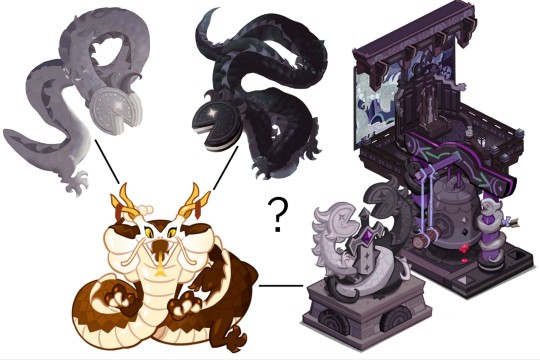
Now what does their supposed kinship has to do with it? Well, eh, I just wanted to somehow connect these two restless souls with too similar destinies, but different ages (I always presumed Affogato is old for some reason): both Affogato and Snake Fruit managed to achieve their goals, but failed to keep them. I can’t say anything about their external resemblance to any of them – based on their appearance, I can rather assume that this is Affogato who's the second parent of Dark Choco, but that’s not the point.
Based on some joking Twitter posts, we've concluded that most likely Choco's mother is White Lily, who created him based on her designs and research (with some help from Dark Cacao, of course), but what happened to her notes when she left to Beast Yeast? They didn't just disappear, did they? So, I came to the conclusion that no, they didn't – which Affogato could have taken advantage of.
Affogato couldn't have been unaware of the circumstances under which Prince Dark Choco was exiled: it might have occurred to him at some point to curry favor with the king by using Lily's notes to create a new heir (possibly even secretly taking a piece from him, resulting in unequal parts). No relations are implied here though: in Cookie Run, one of the semi-«official» methods of reproduction involves breaking off two pieces of dough from the parents to, when combined, create a new cookie.
He didn't take into account, though, that his half ended up disproportionately larger than Cacao's: baby Snake Fruit turned out to be almost a copy of Affogato, and he began to fear that the king simply wouldn't believe him. Add to that Cacao's deteriorating condition due to Affogato's control magic, and we have a deadlock situation: the resulting child needed to be protected.
Affogato could have known that the dragon gene might reveal in Snake Fruit one day. Considering that he himself was a mixture of Coffee Tribe and Milk Tribe residents, and the resulting child clearly reflected his Milk ancestors, it was safe to assume that Dark Cacao's ancestors would eventually manifest themselves too. Keeping this in mind, the idea came to him to send the child far away to Longan, the Dragon Master, to keep them away from harm. They would raise them, nurture them in their home, and perhaps something worthwhile would come out of them, while Affogato figured out how to explain their existence to the king.
Well, along with the genes of Affogato's ancestors, Snake Fruit inherited his nasty character and penchant for intrigue – unwittingly following in the footsteps of one of their parents, becoming an advisor and being cast down for it into the abyss. Hopefully, their body will wash up on the shores of the continent, where their newfound majesties can be picked up by kind people: someone must ultimately look after the king while Caramel Arrow is busy defending the kingdom, and Dark Choco hasn't come to his senses yet.
Literally the only thing that doesn't fit into this theory is Longan themselves: firstly, their dragon appearance somewhat resembles Snake Fruit's dragon form. There's no reason to assume that Longan has any connection to the Dark Cacao Kingdom (unless Snake Fruit hadn't seen their dragon form before). And secondly, Longan... well, they're chauvinist – they wouldn't accept a regular cookie into their service, even if kings were to ask them to. In that case, Affogato would have to persuade the dragons that the child is a hundred percent dragon, just not awakened yet (and by the time it became clear that it's more cookie than dragon, they would have gotten used to their service and simply mockingly called them «Snake»).
Thank you for coming to my Ted Talk again.
#cookie run#cookie run ovenbreak#cr ovenbreak#cookie run kingdom#crk#affogato cookie#crk affogato#dark cacao cookie#dark cacao crk#snake fruit cookie#longan dragon cookie#dragons#white lily cookie#white lily crk
24 notes
·
View notes
Text
How cells make decisions - Technology Org
New Post has been published on https://thedigitalinsider.com/how-cells-make-decisions-technology-org/
How cells make decisions - Technology Org


The central focus of systems biology is the holistic analysis of complex biological data sets, which helps to give us a better understanding of important questions in such areas as cancer research, for example: how do cells respond to changes in their immediate environment, and how is genetic activity controlled during this process? “Our primary focus is on signal transduction cascades, which transmit information from the cell membrane to the cell nucleus,” says Legewie, summarizing the scope of his research. “After that, we’re interested in processing, by which I’m referring to the modification of ribonucleic acids (RNA).” In an attempt to answer these questions, the working group is not only using experiments but also mathematical modeling and artificial intelligence.
Understanding the decision-making processes involved in cancer
In terms of cancer research, the group is investigating a specific signaling pathway with a tumor-suppressive effect, i.e., it is able to block the growth of tumors. One way to picture this is to imagine a hormone-like protein called TGFß, which attaches to receptors on the cell surface. Once this signal has been transmitted to the cell nucleus it activates genes that inhibit cell growth but if the signaling pathway changes, due to mutations for example, TGFß can no longer inhibit the growth leading to excessive cell growth and ultimately cancer. Other changes in the same signaling pathway can cause cells to migrate and a tumor to metastasize.
The primary goal of Legewie’s research group is to gain a better understanding of these decision-making processes in the TGFß signaling pathway that play a role in cancer, whereby they exploit the fact that not all cells in a cell population behave in the same way: some stop growing, whereas others migrate or do not respond in any way at all. “So, what we do,” as Legewie explains, “is to analyze a large number of individual cells and exploit their heterogeneity to understand the underlying decision-making principles.” The findings, which were obtained in collaboration with the University of Darmstadt, were recently published in the scientific journal “PNAS”.1.
Ultimately, the scientists are trying to identify potential targets that can be targeted to reverse the process of tumor development and metastasis. The hope is that it will eventually be possible to develop drugs that will be able to shrink metastasizing tumors.
Legewie’s second field of research, which involves the processing of messenger RNA in cellular protein synthesis, is already much closer to use in therapeutic settings. The result of this processing, which is referred to as alternative splicing, is that human cells have many more protein variants than such things as yeast cells or other lower organisms, which becomes important in treatments, such as CAR-T cell therapy, which is used for end-stage leukemias when the patients’ own immune cells (T cells) are extracted and reprogrammed to make them attack leukemia cells after they are reintroduced to the body.
This treatment is extremely efficient in principle but sometimes the leukemia cells simply don’t respond to the T cells, because T cells are programmed to target a specific receptor on the surface of the cell. This is the very receptor that is processed in a different way in resistant leukemia cells as a result of mutations in the genome, which renders the therapy ineffective.
Predicting the effects of complex mutations
Legewie’s team, is collaborating with groups in Mainz and Frankfurt to gain a better understanding of the principles of resistance development by devising a screening approach that can be used to characterize several tens of thousands of mutations in a high-throughput mapping process, which was reported on last year in the journal Nature Communications.2
What they found was that processing mRNA is enormously complex, as even a relatively short genetic segment of the surface protein gives rise to about 100 variants that could potentially confer resistance. There are also numerous potential combinations of mutations and it is difficult to predict how they will interact. Mathematics has been instrumental in interpreting the relevant data: the research group used various approaches based on systems biology to develop quantitative models that accurately predict the effects of complex mutations on the products of gene transcriptions.
“Going forward,” says Legewie,” we may be able to use this data to predict whether a patient will develop resistance as soon as the treatment starts.” The findings also indicate which other therapeutic approaches CAR T-cell therapy could be combined with in order to guard against resistance.
Source: University of Stuttgart
You can offer your link to a page which is relevant to the topic of this post.
#acids#Analysis#approach#artificial#Artificial Intelligence#Biology#biophysics#Biotechnology news#Cancer#cell#cell therapy#Cells#Collaboration#communications#Computer Science#data#development#drugs#effects#Environment#Fundamental physics news#genes#genetic#Genetics#genome#growth#hormone#how#human#human cells
1 note
·
View note
Text
Synthetic CBD: The Future of Lab-Made Cannabinoids

Introduction
Cannabidiol (CBD) has gained significant popularity in recent years due to its potential health benefits and non-psychoactive nature. Traditionally, CBD is extracted from the cannabis plant, specifically from the hemp variety. However, with advancements in biotechnology and chemistry, researchers have developed methods to produce synthetic CBD in laboratories. This lab-made CBD has opened new avenues for industries that face strict legal restrictions, such as cosmetics. In this article, we will explore the production methods, benefits, and potential applications of synthetic CBD while steering clear of discussing medical CBD use and delving into detail about cosmetic and wellness.
Production Methods: Chemical Synthesis vs. Biological Synthesis

There are two primary methods for producing synthetic CBD: chemical synthesis and biological synthesis.
1. Chemical Synthesis: This method involves using chemicals like limonene, a natural compound found in citrus fruits, as starting materials. Through a series of chemical reactions, these ingredients are transformed into synthetic CBD molecules. The final product is considered bio-identical to naturally occurring CBD, meaning it shares the same chemical structure and properties. This method allows for precise control over the purity and concentration of the resulting CBD product.
2. Biological Synthesis: In this approach, scientists modify yeast or bacteria to produce CBD. By introducing specific genes into the microorganisms, they can effectively "program" them to synthesize CBD. These modified organisms are then cultivated in controlled environments, where they produce and secrete CBD as part of their metabolic processes. The CBD is then isolated and purified from the culture medium. This method is considered more sustainable and environmentally friendly compared to chemical synthesis, as it requires fewer resources and generates less waste.
Benefits of Synthetic CBD
Synthetic CBD offers several advantages over its plant-derived counterpart:
1. Purity: Lab-made CBD can be produced with a high degree of purity, ensuring that the final product is free from contaminants such as pesticides, heavy metals, and other potentially harmful substances often found in plant-based CBD extracts.
2. Consistency: Synthetic CBD production allows for better control over the final product's composition, ensuring consistent quality across different batches. This is particularly important for industries that require strict quality control standards, such as pharmaceuticals and cosmetics.
3. Scalability: Producing CBD in a laboratory setting enables researchers to scale up production as needed, without relying on the cultivation of cannabis plants. This can help meet the growing demand for CBD products more efficiently and sustainably.
4. Legal Compliance: Synthetic CBD can be a viable option for industries that face strict legal restrictions on the use of cannabis-derived compounds. Since synthetic CBD does not come from the cannabis plant, it may bypass some regulatory hurdles, making it an attractive alternative for companies looking to incorporate CBD into their products.
Potential Applications of Synthetic CBD
While we won't delve into the details of cosmetic and wellness applications, it's essential to note that synthetic CBD has potential uses across various industries. Some of these include:
1. Food and Beverage: Synthetic CBD can be incorporated into food and beverages, offering consumers a convenient way to enjoy the benefits of CBD without the need for smoking or vaping.
2. Animal Care: Lab-made CBD can be used in pet products, such as treats and supplements, to support their endocannabinoid system and overall well-being.
3. Textiles: Researchers are exploring the possibility of incorporating synthetic CBD into fabrics and textiles, which could offer unique benefits, such as antimicrobial properties or enhanced comfort.
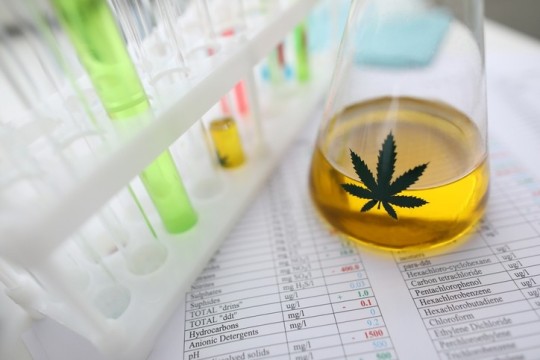
Conclusion
Synthetic CBD presents a promising alternative to plant-derived CBD, offering several advantages in terms of purity, consistency, scalability, and legal compliance. As researchers continue to refine the production methods and explore new applications for lab-made CBD, it is poised to play an increasingly significant role in various industries. With the growing demand for CBD products and the potential benefits of synthetic CBD, it's clear that this innovative compound will continue to shape the future of cannabinoids
0 notes
Text
Science: The Science Behind Your Cheese! The Food is Not Just a Tasty Snack—It’s an Ecosystem
— Ute Eberle, Knowable Magazine | November 30, 2022 | NOVA—PBS
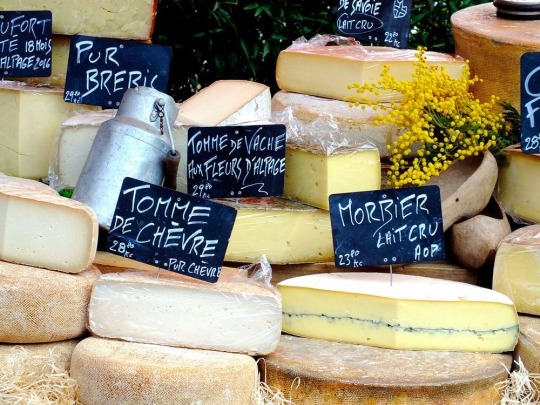
Fungi and bacteria play a big part in shaping the flavor and texture of cheese. BSIP / Universal Images Group via Getty Images
Some cheeses are mild and soft like mozzarella, others are salty-hard like Parmesan. And some smell pungent like Époisses, a funky orange cheese from the Burgundy region in France.
There are cheeses with fuzzy rinds such as Camembert, and ones marbled with blue veins such as Cabrales, which ripens for months in mountain caves in northern Spain.
Yet almost all of the world’s thousand-odd kinds of cheese start the same, as a white, rubbery lump of curd.
How do we get from that uniform blandness to this cornucopia? The answer revolves around microbes. Cheese teems with bacteria, yeasts and molds. “More than 100 different microbial species can easily be found in a single cheese type,” says Baltasar Mayo, a senior researcher at the Dairy Research Institute of Asturias in Spain. In other words: Cheese isn’t just a snack, it’s an ecosystem. Every slice contains billions of microbes — and they are what makes cheeses distinctive and delicious.
People have made cheese since the late Stone Age, but only recently have scientists begun to study its microbial nature and learn about the deadly skirmishes, peaceful alliances and beneficial collaborations that happen between the organisms that call cheese home.
To find out what bacteria and fungi are present in cheese and where they come from, scientists sample cheeses from all over the world and extract the DNA they contain. By matching the DNA to genes in existing databases, they can identify which organisms are present in the cheese. “The way we do that is sort of like microbial CSI, you know, when they go out to a crime scene investigation, but in this case we are looking at what microbes are there,” Ben Wolfe, a microbial ecologist at Tufts University, likes to say.
Early on, that search yielded surprises. For example, cheesemakers often add starter cultures of beneficial bacteria to freshly formed curds to help a cheese on its way. Yet when Wolfe’s group and others examined ripened cheeses, they found that the microbial mixes — microbiomes — of the cheeses showed only a passing resemblance to those cultures. Often, more than half of the bacteria present were microbial “strangers” that had not been in the starter culture. Where did they come from?
Many of these microbes turned out to be old acquaintances, but ones we usually know from places other than cheese. Take Brachybacterium, a microbe present in Gruyère, which is more commonly found in soil, seawater and chicken litter (and perhaps even an Etruscan tomb). Or bacteria of the genus Halomonas, which are usually associated with salt ponds and marine environments.
Then there’s Brevibacterium linens, a bacterium that has been identified as a central contributor to the stinkiness of Limburger. When not on cheese, it can often be found in damp areas of our skin such as between our toes. B. linens also adds characteristic notes to the odor of sweat. So when we say that dirty feet smell “cheesy,” there’s truth to it: The same organisms are involved. In fact, as Wolfe once pointed out, the bacteria and fungi on feet and cheese “look pretty much the same.” (An artist in Ireland demonstrated this some years ago by culturing cheeses with organisms plucked from people’s bodies.)
Initially, researchers were dumbfounded by how some of these microbes ended up on and in cheese. Yet, as they sampled the environment of cheesemaking facilities, a picture began to emerge. The milk of cows (or goats or sheep) contains some microbes from the get-go. But many more are picked up during the milking and cheesemaking process. Soil bacteria lurking in a stable’s straw bedding might attach themselves to the teats of a cow and end up in the milking pail, for example. Skin bacteria fall into the milk from the hand of the milker or get transferred by the knife that cuts the curd. Other microbes enter the milk from the storage tank or simply drift down off the walls of the dairy facility.
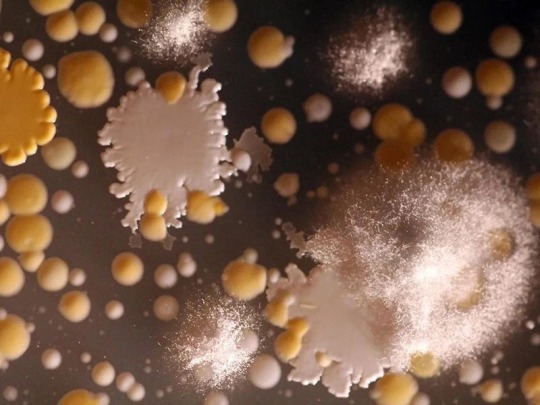
Every cheese is an ecosystem of bacteria and fungi. These microbes were isolated from the rind of a Vermont blue cheese. The orange colonies with ruffled edges are the bacterium Staphylococcus xylosus and the white ones are S. succinus. The small round colonies are several species of Brevibacterium, and the fuzzy white colony is a Penicillium mold. Courtesy of the Wolfe Lab, Tufts University
Some microorganisms are probably brought in from surprisingly far away. Wolfe and other researchers now suspect that marine microbes such as Halomonas get to the cheese via the sea salt in the brine that cheesemakers use to wash down their cheeses.
A simple, fresh white cheese like petit-suisse from Normandy might mostly contain microbes of a single species or two. But in long-ripened cheeses such as Roquefort, researchers have detected hundreds of different kinds of bacteria and fungi. In some cheeses, more than 400 different kinds have been found, says Mayo, who has investigated microbial interactions in the cheese ecosystem. Furthermore, by repeatedly testing, scientists have observed that there can be a sequence of microbial settlements whose rise and fall can rival that of empires.
Consider Bethlehem, a raw milk cheese made by Benedictine nuns in the Abbey of Regina Laudis in Connecticut. Between the day it gets made (or “born,” as cheesemakers say) to when it’s fully ripe about a month later, Bethlehem changes from a rubbery, smooth disk to one with a dusty white rind sprouting tiny fungal hair, and eventually to a darkly mottled surface. If you were to look with a strong microscope, you could watch as the initially smooth rind becomes a rugged, pocketed terrain so densely packed with organisms that they form biofilms similar to the microbial mats around bathroom drains. A single gram of rind from a fully ripened cheese might contain a good 10 billion bacteria, yeasts and other fungi.
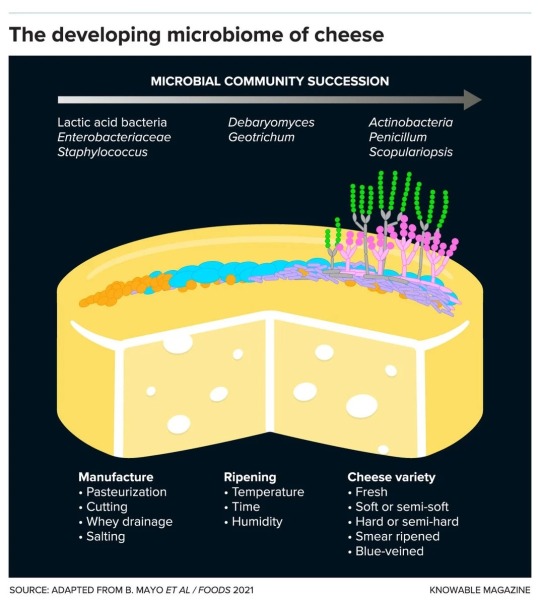
As a cheese matures, the lactic acid bacteria and other early colonists give way to other species of bacteria and, eventually, fungi, in a process known as ecological succession. The details of which species are present depend on exactly how the cheese is made and ripened, and what variety it is. Adapted from B. Mayo et al. / Foods 2021 / Knowable Magazine
But the process usually starts simply. Typically, the first microbial settlers in milk are lactic acid bacteria (LABs). These LABs feed on lactose, the sugar in the milk, and as their name implies, they produce acid from it. The increasing acidity causes the milk to sour, making it inhospitable for many other microbes. That includes potential pathogens such as Escherichia coli, says Paul Cotter, a microbiologist at the Teagasc Food Research Centre in Ireland who wrote about the microbiology of cheese and other foods in the 2022 Annual Review of Food Science and Technology.
However, a select few microorganisms can abide this acid environment, among them certain yeasts such as Saccharomyces cerevisiae (baker’s yeast). These microbes move into the souring milk and feed on the lactic acid that LABs produce. In doing so, they neutralize the acidity, eventually allowing other bacteria such as B. linens to join the cheesemaking party.
As the various species settle in, territorial struggles can ensue. A study in 2020 that looked at 55 artisanal Irish cheeses found that almost one in three cheese microbes possessed genes needed to produce “weapons” — chemical compounds that kill off rivals. At this point it isn’t clear if and how many of these genes are switched on, says Cotter, who was involved in the project. (Should these compounds be potent enough, he hopes they might one day become sources for new antibiotics.)
But cheese microbes also cooperate. For example, the Saccharomyces cerevisiae yeasts that eat the lactic acid produced by the LABs return the favor by manufacturing vitamins and other compounds that the LABs need. In a different sort of cooperation, threadlike fungal filaments can act as “roads” for surface bacteria to travel deep into the interior of a cheese, Wolfe’s team has found.
By now you might have started to suspect: Cheese is fundamentally about decomposition. Like microbes on a rotten log in the woods, the bacteria and fungi in cheese break down their environment — in this case, the milk fats and proteins. This makes cheeses creamy and gives them flavor.
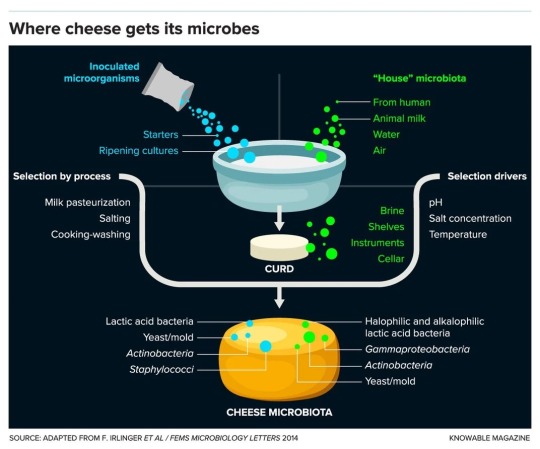
The microbes that colonize cheese come from many places. Some are intentionally added to the milk, while others drift there from the environment and from the cheesemakers themselves. Details of temperature, salt, acidity and other variables determine which of the colonists survive and dominate as the cheese matures. Adapted From F. Irlinger et al. / FEMS Microbiology Letters 2014 / Knowable Magazine
Mother Noella Marcellino, a longtime Benedictine cheesemaker at the Abbey of Regina Laudis, put it this way in a 2021 interview with Slow Food: “Cheese shows us what goodness can come from decay. Humans don’t want to look at death, because it means separation and the end of a cycle. But it’s also the start of something new. Decomposition creates this wonderful aroma and taste of cheese while evoking a promise of life beyond death.”
Exactly how the microbes build flavor is still being investigated. “It’s much less understood,” says Mayo. But a few things already stand out. Lactic acid bacteria, for example, produce volatile compounds called acetoin and diacetyl that can also be found in butter and accordingly give cheeses a rich, buttery taste. A yeast called Geotrichum candidum brings forth a blend of alcohols, fatty acids and other compounds that impart the moldy yet fruity aroma characteristic of cheeses such as Brie or Camembert. Then there’s butyric acid, which smells rancid on its own but enriches the aroma of Parmesan, and volatile sulfur compounds whose cooked-cabbage smell blends into the flavor profile of many mold-ripened cheeses like Camembert. “Different strains of microbe can produce different taste components,” says Cotter.
All a cheesemaker does is set the right conditions for the “rot” of the milk. “Different bacteria and fungi thrive at different temperatures and different humidity levels, so every step along the way introduces variety and nuance,” says Julia Pringle, a microbiologist at the artisan Vermont cheesemaker Jasper Hill Farm. If a cheesemaker heats the milk to over 120 degrees Fahrenheit, for example, only heat-loving bacteria like Streptococcus thermophilus will survive — perfect for making cheeses like mozzarella.
Cutting the curd into large chunks means that it will retain a fair amount of moisture, which will lead to a softer cheese like Camembert. On the other hand, small cubes of curd drain better, resulting in a drier curd — something you want for, say, a cheddar.
Storing the young cheese at warmer or cooler temperatures will again encourage some microbes and inhibit others, as does the amount of salt that is added. So when cheesemakers wash their ripening rounds with brine, it not only imparts seasoning but also promotes colonies of salt-loving bacteria like B. linens that promptly create a specific kind of rind: “orangey, a bit sticky, and kind of funky,” says Pringle.
Even the tiniest changes in how a cheese is handled can alter its microbiome, and thus the cheese itself, cheesemakers say. Switch on the air exchanger in the ripening room by mistake so that more oxygen flows around the cheese and suddenly molds will sprout that haven’t been there before.
But surprisingly, as long as the conditions remain the same, the same communities of microbes will show up again and again, researchers have found. Put differently: The same microbes can be found almost everywhere. If a cheesemaker sticks to the recipe for a Camembert — always heats the milk to the relevant temperature, cuts the curd to the right size, ripens the cheese at the appropriate temperature and moisture level — the same species will flourish and an almost identical kind of Camembert will develop, whether it’s on a farm in Normandy, in a cheesemaker’s cave in Vermont or in a steel-clad dairy factory in Wisconsin.
Some cheesemakers had speculated that cheese was like wine, which famously has a terroir — that is, a specific taste that is tied to its geography and is rooted in the vineyard’s microclimate and soil. But apart from subtle nuances, if everything goes well in production, the same cheese type always tastes the same no matter where or when it’s made, says Mayo.
By now, some microbes have been making cheese for people for so long that they have become — in the words of microbiologist Vincent Somerville at the University of Lausanne in Switzerland — “domesticated.” Somerville studies genomic changes in cheese starter cultures used in his country. In Switzerland, cheesemakers traditionally hold back part of the whey from a batch of cheese to use again when making the next one. It’s called backslopping, “and some starter cultures have been continuously backslopped for months, years, and even centuries,” says Somerville. During that time, the backslopped microbes have lost genes that are no longer useful for them in their specialized dairy environment, such as some genes needed to metabolize carbohydrates other than lactose, the only sugar found in milk.
But not only has cheesemaking become tamer over time, it is also cleaner than it used to be — and this has had consequences for its ecosystem. These days, many cows are milked by machines and the milk is siphoned directly into the closed systems of hermetically sealed, ultra-filtered storage tanks, protected from the steady rain of microbes from hay, humans and walls that settled on the milk in more traditional times.
Often the milk is pasteurized, too — that is, briefly heated to high temperatures to kill the bacteria that come naturally with it. Then, they’re replaced with standardized starter cultures.
All of this has made cheesemaking more controlled. But alas, it also means that there’s less diversity of microbes in our cheeses. Many of our cheddars, provolones and Camemberts, once wildly proliferating microbial meadows, have become more like manicured lawns. And because every microbe contributes its own signature mix of chemical compounds to a cheese, less diversity also means less flavor — a big loss.
0 notes
Text
Benefits of shaving pubic area female – Is it good for a woman?
Our grandmas would have not even imagined discussing the hair down there, but thanks to the media and internet we girls are here researching, debating, and exploring our options on how to groom that little bush. We have so many questions to enquire? Does pubic hair have any purpose? Are there any health benefits associated with them? Can we really fully shave them? Would there be any side effects after shaving them? Here we will try to understand what is pubic hair and the pros & cons of shaving it.
1. Difference between female pubic hair and body hair?
Before we see the difference between the hair in the genital areas to that of the hair in other visible areas of the body, one should know that three main types of hair grow on all human beings. First is the Lanugo hair, the hair growing on the fetus, which is lost once the baby is born. Second is the Vellus hair, the thin, short, and light hair, which covers almost the complete human body except for some areas like the back of the ears, palms of the hands, soles of the feet, etc. The third is the Terminal hair or the Androgenic hair, long and thicker hair, which during puberty replaces vellus hair in certain areas of the body like arms, armpits, legs, pubic, facial hair, etc. The length, color, and thickness of terminal hair vary from person to person depending on the hair growth rate and genes.
2. Pros and cons of shaving female pubic hair:
If you think pubic hair is just a thick bush of wiry hair that is present for no reason, then you are wrong! First of all, these hairs mark the sign of puberty and also acts as a protective shield of the vagina. Following are some of the pros and cons of clean shaving the female pubic hair;2.1. Pros:
Shaving pubic hair has become an aesthetic social norm. Women do it because they believe their genitals look attractive after shaving.
A smooth and soft vagina looks more appealing to sexual partners.
Shaving results in a much cleaner appearance.
Since there is no hair, there is no more sweat and itchiness.
Pubic hair locks the sweaty smell of your vagina and produces a strong odor. So, shaving them eliminates that odor and makes you feel fresh.
Shaving gives you a lot of advantages in dressing. You can flaunt different swimsuits and leggings.
Removing pubic hair increases sexual sensation resulting in a more pleasant experience.
There is no hair and there is no chance for a germ or lice attack.
2.2. Cons:
Removing the safety guard means, you are prone to more infections.
Pathogens and bacteria can cause UTIs, vaginitis, and yeast infections.
Shaving can irritate your skin, leading to skin problems like cellulitis and folliculitis.
Cuts, burns, and rashes are the most common injuries that can occur because of shaving.
Pubic hairs grow back faster and thicker and hence you have to do remove them regularly to avoid the bush.
3. Health benefits of pubic hair female:
As we mentioned earlier these coarse pubic hairs are existing for some reason. They provide some surprising health benefits to women. Some of them are as follows;3.1. Maintains the temperature of the genitals: We all know that animals have fur to keep them warm. Well, our human bodies are not different from them. Hairs serve the purpose of keeping our body warm and pubic hair does the same by maintaining the temperature around female genitals.3.2. Prevents skin rubbing and acts as a buffer: Pubic hair acts as a protective pillow to protect your skin from the friction that may arise from the rubbing of skins during intercourse. This defensive barrier also serves as a shock absorber, when you do certain exercises like cycling.3.3. May reduce the risk of getting an infection: Like how eyelashes protect your eyes, pubic hair acts as a wall and does not allow any dirt, germs, bacteria, and pathogens to enter inside the vagina. The pubic hair follicles produce an oil called sebum, which stops the microorganisms to reproduce and thus minimizing the risk of getting infections.3.4. Attract even powers due to pheromones: Pheromones are scented chemicals secreted from apocrine sweat glands, which are abundant in the pubic region. People believe in the theory that these pheromones are trapped inside the pubic hair and their smell can be sexually tempting and enticing for your partner.
4. Top benefits of shaving pubic area female:
Shaving pubic hair is totally based on your personal preferences. If you are determined to make that choice, “say hurray!”, you get to enjoy the following cool benefits;4.1. Eliminating odor: When you get rid of your pubic hair, you also remove the apocrine sweat glands. This will leave you with an odorless vagina.4.2. Healthier: Once you shave the bush, your pubic area will look much cleaner without any itching or irritation.4.3. Better intercourse: Studies say that men are more attracted to hair-less pubes. If you find oral sex fascinating, then you should definitely go for shaving your mound with a nice sharp razor.4.4. Increased sexual activity: Some theories suggest that there is a link between vaginal hair removal and sexual functionalities. Many young people report that there is an increase in sexual sensation after they remove their pubic hair.4.5. Looks better: Having soft and smooth vaginas make women feel more confident and comfortable in dressing whatever they like.
5. Possible consequences of removing pubic hair:
Depilatory creams can cause chemical burns to your sensitive skin.
There can be redness, irritation, and itching after removing the pubic hair.
Cuts, bruises, and boils can appear.
One may get infected with “Hair root infection” which is commonly caused due to shaving.
6. Should one use an electric razor for pubic hair removal?
Electric razors are long-lasting, portable shavers that come with a variety of additional features. One can even choose to have a dry or a wet shave depending on their preferences. Electric razors are safer than manual razors because there are fewer or no chances of cutting. However manual razors can provide a quick and close shave than electric razors, with a high risk of getting injured. You can choose by deciding which shaving method would best suit your needs and lifestyle.
7. Side effects of pubic hair removal:
As mentioned earlier, some consequences or side-effects are resulting from shaving pubic hair. There are some suggestions to help you treat these at your home, but you may have to consult the doctor for a permanent solution.7.1. You can relieve the discomfort in the following ways:
Soak yourselves in a warm bathtub or take a warm shower. The hot water will help you in cooling off your bruises.
You can also try keeping your vaginal area dry by patting the area gently with a clean towel.
Once you finish drying, apply skin moisturizing lotions. This will avoid any irritation or burns.
Give your labia a break! Stop shaving until your skin gets completely healed from any infection.
8. Safety guidelines for shaving the pubic hair:
The skin present in the labia is very different from the skin on other parts of the body. It is very thin and less taut. It also has more nerves ending at its surface which makes it more sensitive for shaving. But if you follow the following safety guidelines you would get a scar-free shaving experience along with a smooth fur-free vagina.
It is given that you cannot see your vaginal area properly during the shaving process. So, you can use a hand mirror to see clearly and to avoid any cuts.
You can cut the long hair with a sharp scissor before shaving.
Warm water helps in softening the pubic hair which in turn eases the process of shaving.
Gently exfoliate the skin with pH-balanced shaving cream or gel. This will help to loosen up the trapped hairs.
Always use a sharp razor for a neat and closer shave.
Sterilize the razor before you use it.
Start shaving with slow movements in the direction of the hair growth.
Do not forget to rinse your razor in warm water after every single stroke.
Once you finish shaving, rinse your skin in a warm shower and dry your skin gently by patting it with a towel.
Develop a post-shave care routine by applying a lotion or moisturizer. Hydrating the skin is a must to avoid any irritation or itchiness.
9. Tips for shaved genitals:
Here are some additional tips on how to shave and how to take care of your skin and maintain it after the shave;9.1. During hair removal:•Razors with easy-grip: For better control choose razors with an easy-to-grip handle, when you are shaving in the shower. •Shower or bath mat: Use a shower mat or bath mat to avoid any accidental slips and slides.• Water temperature: The temperature of the water should be neither too hot nor too cold. It has to be just warm.9.2. After hair removal:
Say no to tight lingerie: Very tight-fitting underwear can cause irritation to your just shaved soft vulva. Wearing cotton panties is a good solution.
Do not expose your skin to the sun: Let your skin recover after shaving before you go out in your swimsuit to get a sunbathe or enjoy your time in the pool.
Pay attention to abnormalities: If you see any abnormal changes in the labia, check with your dermatologist immediately to avoid any unnecessary complications.
10. Conclusion: Most of the girls shave their pubes because their partners ask them to do so or they would like to look better for their gynecologist visits. Ultimately, what you do with your hair, whether you trim, shave or leave it natural, is all up to your preferences.
6 notes
·
View notes
Note
If the way lichens are named is based on outdated information, do you know what ways of renaming them have been proposed to bring them more in line with current knowledge? I imagine naming them by just listing the component species would get unwieldy VERY fast.

yeaaahhh exactly, that’s the main problem. the only major other thing ive seen proposed is the theory that the ‘real’ name of any given lichen is it’s common colloquial name, because the way it exists to us just like, walking in the woods or whatever can be encompassed under said name, but as you can imagine that’s a more philosophical take on it.
here’s my take, aka ‘what i would do if i suddenly got spontaneous control over all of lichenology’. basically i feel like there’s a few major things that need to happen before we can even start reliably identifying what’s in the lichens themselves.
to start out, the distress, as i see it, is coming from this idea that we should have to know all the given components of a lichen just from the name. the philosophical idea above tells us why this is impractical: if everyone knows the lichens by a certain name, and all the keys are meant to provide identification down to a certain name, then it really, really seems like we should keep the names on a general level, because the names themselves are doing their jobs; you go to an herbarium and you can find a group of lichens that look the same, but may not have the exact same morphological features and may not test ‘correctly’ on certain chemical tests, indicating different yeasts or something similar.
meanwhile, the yeasts themselves are…weird. the researchers in the paper found out about the presence of yeasts essentially by accident while trying to figure out why two otherwise identical lichen species (Bryoria fremontii and Bryoria tortuosa) had radically different levels of vulpinic acid; there were papers before that did genetic testing, with no explanation as to why they were so radically different. these researches hypothesized that it was because of different genes being expressed, and did more genetic testing (specifically a transcriptome-wide SNP analysis for those interested) to find that yes, both lichen species are indeed genetically identical– but they were telling the computer running the analysis to search only for known lichenized algae and fungi species. once they expanded the analysis to produce results for any fungi species detected in the samples, they found out about the yeasts, and realized that more yeast seemed to equal more vulpinic acid.
i tell this extended story because it raises crucial questions about how we identify lichens. these researchers did an extended battery of genetic testing to determine the yeast species in the samples, but in functional lichen identification that happens everyday this is like….so far out of reach it’s laughable. when we identify lichens in the herbarium we plop em down on the lichen bench and follow through a dichotomous key, and the tests include things like ‘drop bleach on the thallus and if it turns a certain color it’s X species and if not it’s Y species’ and ‘look at the lichen under UV light and if it glows a certain color it’s X species and if it doesn’t it’s Y species’. the color lichen thalli turn under these conditions indicate different levels of certain chemicals, or the presence or absence of certain chemicals, and often the key will tell you what chemical is being indicated, and will direct you around depending on the results.
the problem with this is that not all lichens test positive on all chemical tests all the time. it’s a regular thing to have a lichen that like, 400% looks like a certain species but fails a chemical test and is labelled as another, slightly different species instead, and likewise it’s common to have lichens labelled as a certain species that have different chemical test results.
if we’re working off the assumption that the basis for these minute differences is the species of yeast in the lichen, then we would have to decide– ‘we’ meaning all lichenologists as an academic field, i suppose– whether or not the yeast actually matters, or if it’s entirely conditional. for example, take the infamous Bryoria fremontii and Bryoria tortuosa riddle above. in this case the yeast was like, the answer, and the crucial question then would be, ‘are these the same species but in different forms, or are these two different species differentiated by the species of yeast?’. if it’s the former, then hell, identifying the yeast doesn’t matter, and we can just lump them all in and say that the darker color is the yeastier form or w/e. if it’s the latter, suddenly we have the question of what the chemical tests that have been standard for years actually mean: are they yeast tests??? which yeasts make which colors??? does it change depending on the lichen?? does it matter, if the keys can stay functionally the same??? are we splitting all lichens up based on their yeasts?? what’s happening???
my solution, theoretically, would be this:
1. we keep the names. just keep them. everybody knows them by the names, all the herbariums have them put in place with the names, etc. yeah lichen names get changed all the time bc of taxonomy discoveries, but it’s sure as hell not practical to just like, do away with all the current names, no matter how weird the archaic fungus-first model is to begin with.
2. we figure out how to identify the yeasts, whenever and wherever they are present. preferably this can be done with a low-cost dropper test or something similar to what’s already normal for lichen ID. best case scenario, this means just finding out which chemical test results can be associated with certain yeasts reliably, i.e. ‘x species of yeast produces vulpinic acid, and when exposed to bleach on the thallus of this lichen the vulpinic acid turns a certain color, and if it is that color then i can know it’s not just the chemical itself that is present but that x species of yeast in the lichen is the cause of that chemical’.
3. we get in the habit of writing down on the labels of samples which yeasts are found through said methods. what this would turn out, i have no idea; if we start finding like, 80 kinds of yeast per set of herbarium samples, we’d be in deep shit, but if it’s a simple matter of finding out that half the species in the herbarium have different yeasts from the sample next to them in the box, that would be a little easier to handle.
4. as for fixing the fungi-centric naming issue as a whole: i propose, again, that we keep the names, and instead find some way of indicating easily which combination is present. this, as i have it in my head, would be pretty cumbersome and would probably need a lot of revising to actually be practical, but if lichens are as diverse on a microbiological level as we’re finding out they are, then a flexible coding system would be best. like a dewy decimal system of lichens. we write out all known symbiotes into a chart or put it in an excel program or something, associate a number with each symbiote, and then just put them together, we could come out with a specific number for describing a lichen based on it’s components, in addition to the name, like so:
[FUNGUS #] - [ALGAE #] - [YEAST #] - [BACTERIA #]
001 - 020 - 2384 - 2
if the lichen doesn’t have a yeast or a bacterial symbiote, it just gets omitted:
001 - 020
if there’s a second fungus, then the two fungus numbers get put together:
001/004 - 020 - 2384 - 2
if a species in unknown, it gets the code 000:
001 - 020 - 000 - 2
a lichen that can be keyed to a genus but not a species has an asterisk next to the unknown numbers:
001 - 020* - 000 * - 0*
is this an incredibly convoluted system? yes. does it solve the combination problem, hypothetically? maybe. possibly. who knows. it would be useful in finding lichens with a very specific combination easy to find en masse in a database or something, though.
303 notes
·
View notes
Text
What Are The Peptides Types?
Changing Artificial Peptide Manufacturing
Content
Disulfide Bond.
History Of Solid Phase Peptide Synthesis (spps).
Just How To Take Powder Sarms.
Quality Assured Sarms.
Imuscle Pile Hulked X2, Pct.
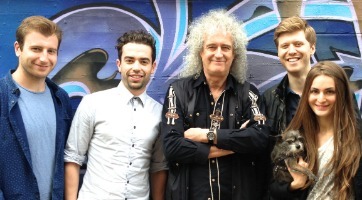
Peptides as well as vitamin C are 2 active ingredients developing quite a buzz in the world of skin care, credited for helping to lighten up as well as bring glow to the skin-- not to mention boost the look of ageing indicators. So, to assist you progress acquainted with these energetic ingredients as well as decide if your regular needs them in it, we have actually written a bluffer's guide bursting with realities regarding these powerful skin heroes. Fermentation with Lactobacillus microorganisms has major applications in the food industry.
Is Rad 140 stronger than testosterone?
Animal studies. According to a study conducted by researchers at the University of Southern California, Los Angeles, RAD 140 appears to be safer than testosterone replacement therapy (TRT) in rats. Further research is required to determine if RAD 140 is also safer than TRT in human subjects.
Buy post cycle therapy support for cyclic knottins, Biochemistry, 2001, 40, 7973-- 7983 CrossRef CAS PubMed. , Remedy frameworks by 1H NMR of the novel cyclic trypsin inhibitor SFTI-1 from sunflower seeds and an acyclic permutant, J. Vitamin C plays a fundamental part in the healthy functioning of the body-- from aiding to increase the body immune system to avoid points such as heart disease.
Disulfide Bond.
This might disrupt the acetylation and deacetylation procedure, which consequently can result in carcinogenesis. Inhibition of HDAC enzymatic task is expected to generate re-expression of differentiation-inducing genes. The overall benefit of this is to substantially enhance lifestyle and survival times for patients. https://direct-sarms.com/product-category/sarms-stacks/ & Histone online shop Detailed series of Chemokine as well as Histone products with worldwide delivery and online discount rates offered.
SARM Election priorities for rural Saskatchewan - Yorkton This Week
SARM Election priorities for rural Saskatchewan.
Posted: Tue, 29 Sep 2020 07:00:00 GMT [source]
The yeasts are much more different and less concentrated than baker's yeast, so they elevate the dough extra gradually. The lactic acid bacteria also call for numerous hours of fermentation to work their wonders. In terms of allergic reactions, family pets unable to tolerate "basic" pet foods can be fed a certain hydrolysed healthy protein diet. For these solutions, hydrolysed protein is made use of as the main healthy protein resource of the diet.
History Of Strong Stage Peptide Synthesis (spps).
Level of sensitivity and specificity concerns are countless such as fewer particles per quantity, enhanced fragmentation as well as limited recuperation because of complicated sample preparation, to name a few. Chemistry consumables that collaborate with your system to maximize sensitivity, increase throughput and make sure the advancement of robust approaches. The minimum sensitivity discovery limit of attaching peptide (c-peptide) making use of existing human c-peptide ELISA package was roughly 0.064 ng/ml. Human c-peptide ELISA set is a reputable quantitative treatment for gauging attaching peptide (c-peptide) in human lotion, plasma and also urine. These enzymes take care of stabilizing the vibrant procedure of acetylation and also deacetylation of the amino teams of lysine at the N-terminal tails of the core histones. Inequality in this procedure can bring about changes in the transcriptional regulation of genetics involved in crucial functions like the distinction and also apoptosis procedures.
Androgen receptor stops tumor growth in the most common form of breast cancer - Newswise
Androgen receptor stops tumor growth in the most common form of breast cancer.
Posted: Thu, 26 Mar 2020 07:00:00 GMT [source]
, Molecular residential or commercial properties that influence the dental bioavailability of medicine prospects, Journal of medicinal chemistry, 2002, 45, 2615-- 2623 CrossRef CAS PubMed. , Synthesis and also organic tasks of brand-new side chain and backbone cyclic bradykinin analogues, J. , Peptide ranges with made second structures for healthy protein characterization using fluorescent fingerprint patterns, Biopolymers, 2004, 76, 129-- 139 CrossRef CAS PubMed. , Solution structure of the squash trypsin inhibitor MCoTI-II.
Just How To Take Powder Sarms.
Following an extensive examination, the outcomes concluded that eliminating glycerine from both pet cat and dog snacks is feasible when using Salmigo Secure L60 as a substitute. Due to the Covid-19 pandemic, the seminar was canceled by the organizers (delayed to August 9-10, 2021). The occasion will be held in Dublin, a vibrant and also inviting city. The meeting covers subjects from healthy protein, carb, and also nucleotides chemistry extensively specified, varying from artificial method to translational applications. Bicycles are extremely flexible, permitting fast setting up into much more complex particles.
Researches have actually revealed the ability of SARMs to enhance muscle as well as bone mass significantly in animals while having no negative effect on the prostate.
Have not felt anything while using this yet this increase in toughness practically tells me all I require to understand about the efficiency of this product.
What would you recommend as a sarms pile that is safe with the Lipator?
Most of the moment, a post cycle treatment is usually never ever required either, which is what makes them so appealing to athletes over typical steroids.
Used this to keep strength on cut, however actually allowed for me to enhance weight on all exercises at upkeep calories, this functions like a moderate PH, it is a great different anabolic.
This week attempted hefty shoulder presses, and obtained a brand-new personal best.
The diets are very well endured from a digestive system perspective and might be administered with no change period. They also contain suitable quantities of extremely digestible healthy protein. Diet plans manufactured with hydrolysed healthy protein (e.g. soya, hen heart and also liver as well as casein) have actually been readily available for some years now as well as, adhering to a variety of large researches, they can be advised for use with a great level of certainty. DIETARY allergy or intolerance are often manifested by the very same scientific indications-- dermatologic indications as well as intestinal signs-- from vomiting, variable feceses, frank enteritis, colitis and some reported instances of inflammatory digestive tract condition. to direct-sarms Buy bulking stacks to its exceptional mass resolution capabilities, high resolution mass spectrometry is currently being used to conquer bioanalytical quantitation difficulties facing little and also large particle advancement profiles. Large molecule quantitation is among the greatest challenges that bioanalysts encounter.
Top Quality Guaranteed Sarms.
Yet sourdough LABORATORY generate organic acids that, under the warmth of baking, cause communications that reduce starch accessibility. The most affordable GI breads are whole-grain sourdoughs with a portable structure. Bread, especially if made with unrefined flour, is a substantial source of dietary minerals such as iron, calcium, magnesium and zinc. However a piece of fast-made wholemeal may be nourishing only in theory if its components pass right with the body without being taken in. The major offender below is phytic acid, present in the bran layers of cereals, which 'secures' the essential minerals. Several hours of fermentation with sourdough is sufficient to neutralise phytic acid and also make the minerals a lot more bioavailable (12-13). Sourdough is a culture of yeasts and also valuable microorganisms that occur naturally in bread flour and also dough.
Under the Certificate arrangement, Jitsubo will establish selected manufacturing procedures using their Molecular Hiving ™ modern technology and transfer these processes to Bachem. Bachem will certainly further maximize, scale up as well as generate for industrial applications. Systemic RALA/iNOS nanoparticles; a potent genetics treatment for metastatic bust cancer cells coupled as a biomarker of treatment. Advancement and characterization of self-assembling nanoparticles utilizing a bio-inspired amphipathic peptide for gene shipment. Many different chemical moieties can be suited by our technology as shown in Fig. One of the world's leading research institutes, our scientists are functioning to advance understanding of biological procedures at the molecular degree - supplying the knowledge needed to address essential troubles in human health. The research was executed by Passion4Feed-- an independent petfood study center in Norway-- making use of the salmon peptide Biomega branded product, Salmigo Protect L60.
Diabetes Mellitus Discussion forum Application Find assistance, ask questions and also share your experiences with 328,007 participants of the diabetes community. Reduced Carb Program Join 450,000 people on the acclaimed application to sustain healthier practices and weight-loss for people with excessive weight, prediabetes and also type 2 diabetes.
Are SARMs Safe 2020?
Body-building products that contain selective androgen receptor modulators, or SARMs, have not been approved by the FDA and are associated with serious safety concerns, including potential to increase the risk of heart attack or stroke and life-threatening reactions like liver damage.” The agency adds: “Consumers
Examples consist of soya healthy protein isolate and plume protein hydrolysate. As a whole it is taken into consideration that just complex particles, such as water soluble glycoproteins, are able to boost the immune system and also trigger a sensitive response. Many generally, the glycoproteins are in the range of 14 to 40kDa, although smaller and bigger compounds might additionally be immunogenic.
This powerful antioxidant is likewise dazzling at taking on indications of ageing in the skin as it aids to shield it from age-accelerating aggressors in the environment such as UV, cigarette smoke and also contamination. Normal use should aid your complexion look better and also smoother, while decreasing great lines, wrinkles as well as image damages.
youtube
, Crystal framework of murine cyclophilin C complexed with immunosuppressive medication cyclosporin A, Proc. , Mucosal peptide hydrolase as well as brush-border marker enzyme tasks in three areas of the small intestine of rats with speculative uraemia, Clin.
C-peptide is a beneficial pen of insulin manufacturing since c-peptide often tends to stay in the blood longer than insulin. For each molecule of insulin created there is a particle of c-peptide.

Hypo Program The initially comprehensive, cost-free as well as open to all on-line step-by-step overview to boosting hypo awareness. NHS-approved evidence-based behavior change app for individuals with kind 2 diabetic issues, prediabetes, weight problems and those seeking to optimise their wellness and wellbeing. People who make use of Reduced Carbohydrate Program have actually accomplished fat burning, enhanced HbA1c, minimized medications and kind 2 diabetic issues remission. High degrees of c-peptide but low blood glucose levels may be a result of insulinoma unless sugar decreasing medicine has influenced the outcome. Low degrees of both c-peptide as well as blood glucose can suggest liver illness, a serious infection or Addison's disease. For the blood examination itself, a sample of blood will be taken from your arm as well as it should not take a lot more than a min. If you take blood glucose reducing medicine you will likely be asked to quit taking these in the run up to the test.
#sarms stackss#sarms cutting stacks#bulking stacks#muscle building stacks#shredding stacks#support#cycle support supplements#post cycle therapy support#test base support#Buy sarms stackss#Buy sarms cutting stacks#Buy bulking stacks#Buy muscle building stacks#Buy shredding stacks#Buy support#Buy cycle support supplements#Buy post cycle therapy support#Buy test base support
1 note
·
View note
Text
TAFAKKUR: Part 126
Spider Silks: Part 2
Analysis of silk
The silk itself is a material identified as a “scleroprotein.” When created in the glands it is a fluid; only when dragged outside the body does it solidify into thread. Once it was believed that contact with air produced the toughening, but it currently looks that the drawing-out activity alone is accountable for the change.
To carry out the exertion done by the glands, a spider is armed with spinnerets, usually six in number. These are as accommodating as fingers; they can be prolonged, compacted, and overall be applied like human hands. In the “spinning field,” where the spinnerets are congregated, single threads are joined into numerous compound threads, and some of the dehydrated threads may be covered with a gluey substance. Thus, a completed thread may be thin or thick, dry or sticky. It may also have the look of a bead-trimmed necklace. For the last kind, the spider spins rather unhurriedly and, drawing out the gluey thread, lets it go with a jolt. The liquid thus is organized in beads spread out lengthwise across the completed line.
The strand known as the dragline may be understood as a spider's “life line” because it performs as a lifeguard in all kinds of situations. The dragline goes along with the spider, no matter where or how far it journeys, winding out from spinnerets at the back of the body. It forms a portion of the building of webs, it grips its tiny builder firmly in problematic places, and it helps in absconding from adversaries. When a spider is inactive in a web, the dragline enables a rapid descent and escape. It allows energetic chasing spiders to jump from buildings, cliffs, or any tall position with absolute security.
Benefits of spider silk to us
The silk of the silkworm could be very profitable and marketable. There are, however, challenges. One is the changing thickness of a spider’s strand; the other is that it doesn’t well endure the interweaving process. Housing and feeding large numbers of silkworms is not difficult. But housing and feeding large numbers of spiders? There are enormous difficulties.
Native inhabitants of New Guinea have used spider silk in a variety of conditions. They make fishing nets, traps, and such objects as bags, headdresses that will keep away rain, and caps. These are not formed from single threads but from tangled, warped threads. The aboriginals of North Queensland, Australia, look to spiders for their angling supplies.
Spider silk has been valuable to the manufacturers of such complex instruments as astronomical telescopes, guns, and engineers’ levels. The threads, being exceedingly fine but nonetheless robust, are outstanding for sighting marks. Throughout the Second World War, there was a significant demand for spider thread for surveying and laboratory instruments. Black widow spiders were utilized for the manufacture of this silk.
One drawback to the use of spider silk in industry is that it might slump in a moist environment. To overcome this problem, strands of platinum or etching on glass plates take its place in such instruments as periscopes and bombsights.
Spider’s silk also might have healing properties. Due to its antibacterial properties and because the silk is abundant in vitamin K, it may be efficient at clotting blood. Because of the problems in obtaining and handling extensive amounts of spider silk, the largest known piece of cloth made of spider silk is an 11 by 4-foot (3.4 by 1.2 m) fabric made in Madagascar in 2009. Eighty-two persons labored for a period of four years to gather over one million golden orb spiders and extract silk from them.
Applications of spider silk
As mentioned, human beings have been using spider silk for thousands of years.
The manufacture of contemporary synthetic super-fibers such as Kevlar (bulletproof material) includes petrochemicals, which adds to pollution. Kevlar is also strained from concentrated sulphuric acid. In comparison, the manufacture of spider silk is totally ecologically sustainable. It is created by spiders at ambient temperature and pressure and is strained from water. Furthermore, silk is totally biodegradable. If the manufacture of spider silk ever becomes industrially practical, it could be a substitute for Kevlar and be used to create a varied extent of articles such as: bulletproof vests, wear-resistant lightweight clothing, ropes, nets, seat belts, parachutes, rust-free boards on motor vehicles or boats, biodegradable bottles, bandages, surgical thread, artificial tendons or ligaments, and backings for weak blood vessels.
Synthetic spider silk
Duplicating the multifaceted settings needed to make threads that are similar to spider silk has been difficult to both research and manufacture. Through genetic engineering, Escherichia coli bacteria, yeasts, plants, silkworms, and animals have been utilized to produce spider silk proteins. Yet, these synthetic threads have diverse, simpler features than those of a spider. Manmade spider silks have lesser and unsophisticated proteins than natural dragline silk, and have subsequently half the diameter, strength, and flexibility.
One tactic is to remove the spider silk gene and utilize additional life forms to generate the spider silk. Canadian biotechnology company Nexia effectively produced spider silk protein in transgenic goats that passed the gene for it; the milk made by the goats comprised noteworthy amounts of the protein: 1-2 grams of silk proteins per liter of milk. To make spider silk, Nexia utilized damp whirling and pressed the silk protein across minor extrusion cavities in order to mimic the performance of the spinneret, but this process was not adequate to duplicate the sturdier characteristics of innate spider silk.
In March 2010, investigators from the Korea Advanced Institute of Science and Technology was able to produce spider silk by means of the bacteria E. coli, altered with definite genes of the spider Nephila clavipes. This tactic removes the necessity of milking spiders.
It should be noted that the manufacture of spider silk is not easy and there are intrinsic difficulties. First of all, spiders cannot be cultivated like silkworms since they are flesh-eaters and will merely eat each other if in proximity to each other. The silk produced is very slight, so 400 spiders would be required to make only one square yard of cloth. The other problem is, silk also toughens when subjected to air, which makes working with it problematic.
A different tactic is to study how spiders whirl silk and then replicate this process to make artificial spider silk. The silk itself would also have to be synthetically produced. Chemical production of spider silk is not feasible at present due to the absence of information about the makeup of silk. Randolph V. Lewis, Professor of Molecular Biology at the University of Wyoming in Laramie, has introduced silk genes into Escherichia coli bacteria so that the recurring sections of spidroin 1 and spidroin 2 efficaciously come to form. Others theorize about the likely gene introduction into fungi and soya plants. It may also be possible to modify the silk genes for precise intentions.
Why a spider’s house is the frailest of houses
Spider silk is stronger than steel, but the Qur’an (29:41) states that the flimsiest of houses is the spider’s house. The per unit weight of the dragline silk of the golden orb spider is one of the world’s hardest fibers. Webs are combinations of many kinds of spider silk, all able to be produced by the same spider. The web radials are strong, but the somewhat feebler circumferential (quasi-circular concentric) fibers are flexible and gluey to absorb the energy of a flying insect and hold it in place. The strongest of all is the fiber, which the spider uses for transport, the dragline silk. In summary, the spider fabricates both sturdy as well as feeble fibers and the web it weaves to catch flying insects is weaker; this may be the reason why it is referred to in the Qur’an as the “frailest” of houses.
Conclusions
Scientists are foreseeing many potential uses for biosilk. Textile usages are noticeable one. The flexibility and potency of prevailing merchandises such as spandex and nylon have to be improved. Since it is lightweight, hardy and flexible, biosilk may also have uses in satellites and aircraft. More prominently, the new group of progressive things that spider silk investigation may cause has the prospective to alter our lives in innumerable manners that we can barely imagine. More than 72 years have passed since the inventions of Wallace and Carothers that gave the world nylon that led us into the age of polymers. Artificial spider silk may help produce super-performing clothes of the future. Earthquake resistant suspension bridges hung from cables of synthetic spider silk fibers may someday be a reality.
#allah#god#muhammad#prohet#sunnah#hadith#quran#ayah#islam#revert#muslimah#hijab#help#convert#religion#muslim#reminder#dua#salah#pray#prayer#welcome to islam#how to convert to islam#new muslim#new revert#new convert#revert help#convert help#islam help
1 note
·
View note
Text
Animal/Bio-Diversity Facts!
I combined these two topics because there’s a lot of overlap, and I decided that taking notes on both really helped me understand what the other is trying to say. This will be a long post, strap yourself in.
Organisms are organized and classified via a system known as Taxonomy. This system was developed by a scientist named Carl Linnaeus. To identify individual organisms, binomial nomenclature is used. What this means is each organism is called by their genus and species name. For example, Homo sapien, Pyrrhura molinae, (Green cheek conure), and Betta splendens.
There were originally 6 taxa or levels of organization developed by Linnaeus; kingdom, phylum, class, order, family, genus, and species. The 20th century saw many changes to Linnaeus’ original system of organization. The 3 original kingdoms were expanded to 5; Monera, Protista, Fungi, Plantae, and Animalia, a 6th, Archaebacteria was added to represent extremophiles that were so intense they had to be separated from bacteria to give their coolness more merit.
Today's scientists added a 7th level, domain. We use a 3-domain system based on DNA analysis. These domains are eukarya, bacteria, and archaea. Monera stopped being used as the prokaryotes were split between bacteria and archaea. Archaea are in fact, not bacteria, and so were given their own domain.
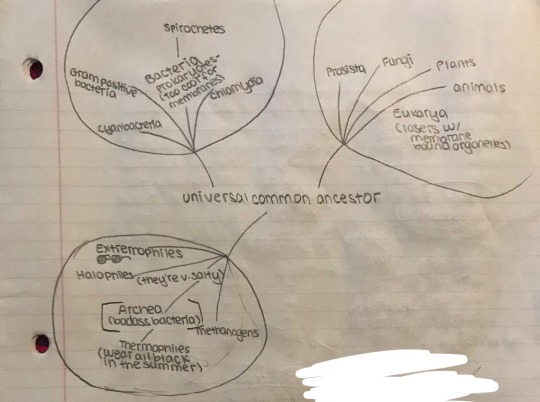
Here are some characteristics shared among members of the same domain:
Bacteria
All members of this domain are unicellular prokaryotes. This means that they lack internal membranes, like a nucleus, mitochondria, or chloroplasts)
Some are anaerobic (metabolize without oxygen) some are aerobic (metabolize with oxygen)
In the environment, some are decomposers, meaning they decompose and recycle dead organic material.
Some are pathogens, such as some strains of E.coli.
Speaking of E.coli, they also play a vital role in genetic engineering. E.coli is used to manufacture human insulin
Some reproduce using conjugation. This is a primitive process, where individuals exchange genetic material
They have a thick and rigid cell wall
Some, like blue-green algae, are autotrophic (make their own food) others are heterotropic (depend on complex organic substances for food)
Have no introns (noncoding segments of DNA)
Archaea
Also unicellular prokaryotes
Include extremophiles, which are organisms that live in extreme environments. Some examples are Methanogens (obtain energy by producing methane from hydrogen) Halophiles (thrive in extremely salty environments, such as the Dead Sea) and Thermophiles (thrive in extremely high temperatures, like Yellowstone's hot springs)
Have introns present in some of their genes
Eukarya
Have a nucleus and internal, membrane-bound organelles
Include: Protista, Fungi, Plantae, and Animalia
Moving into kingdoms, there are 4. These are the 4 mentioned above, fungi, Protista, Plantae, and Animalia. Here are some traits for each:
Protista
Most are unicellular, however, some are primitive multicellular organisms.
Include both heterotrophs (like amoeba, and paramecium) and autotrophs (like euglenas)
Move using different structures, such as pseudopods in amoeba, cilia in paramecium, and flagella in euglenas.
Include organisms not cool enough to sit with the fungi or Plantae kingdoms, like seaweed and slime mould.
Some, like algae and paramecium, carry out conjugation
Some can cause serious diseases like amoebic dysentery and malaria
Fungi
All are heterotrophic
Include unicellular and multicellular organisms
Able to digest extracellularly by secreting hydrolytic enzymes, and absorbing the nutrients via diffusion.
Are essential to the environment, as they are decomposers. They are saprobes, which mean they eat decaying organic matter.
They have cell walls, however, unlike plants whose cell walls are made of cellulose, their cell walls are made of chitin.
Lichens are fungi and algae living in a mutualistic, symbiotic relationship. Lichens are strong enough to withstand harsh, unforgiving environments, thus are often the pioneer organisms (the first to colonize a new environment).
They reproduce asexually by budding, like yeast, spore formation, like bread mould, or fragmentation (aka 1 parent breaks itself into several, living pieces), however, some can reproduce sexually.
Plantae
All are multicellular, nonmotile, and autotrophic.
Their cell walls, as mentioned above, are made of cellulose.
Plants can create their own food by photosynthesis, which uses chlorophyll a and b.
Their carbohydrates are stored as starch
They reproduce sexually by alternating between the gametophyte and sporophyte generations.
Some (tracheophytes) have vascular tissue while others (bryophytes) do not.
Animalia
All are heterotrophic, multicellular, and motile
Most reproduce sexually with a dominant diploid (2n) stage
In most, a sperm with a flagellum fertilizes a large, nonmotile egg.
Animals are classified, traditionally based on anatomical features (homologous structures) and embryonic development.
There are 35 phyla. Since I want to eat something today, I’ll go over the 9 the Barron’s SAT book describes, which are Porifera, cnidarians, Platyhelminthes, nematodes, annelids, molluscs, arthropods, echinoderms, and chordates.
Each animal phylum represents the evolution of a new, successful body plan. Some of these trends include specialisation of tissues, germ layers, body symmetry, the development of a head end, and body cavity formation.
Specialized cells, tissues, and organs
The cell is the basic unit of all life, for example, fat cells. Tissue is the next block up and is a collection of tissues performing a function, such as adipose tissue. An organ is a group of tissues working together to perform a similar function. For example, the brain.
Organisms making up the phylum Porifera, like sponges are made of a loose confederation of cells. Since those cells are not specialized, they are not considered tissue. These cells can react to stimuli, however, lack muscle or nerve tissue.
Organisms making up the phylum cnidaria possess tissue, however the most primitive and simple form of tissue. However, no organs. Flatworms do have organs, however, lack an organ system. Annelids, however, possess a full organ system.
Germ Layers
Germ layers make up the tissues and organs of the body. They form early in embryonic development. There are 3 kinds, however, not all organisms have all 3.
Ectoderm- outermost layer, makes up skin and nervous system
Mesoderm- middle layer, becomes blood, muscles, and bones
Endoderm- innermost layer, makes up the viscera (guts)
Porifera and cnidarians only have 2 layers. They lack mesoderm and instead have mesoglea or middle glue which holds the 2 layers together. Organisms that have 3 true germ layers are called triploblastic.
Body Symmetry
Most primitive animals exhibit radial symmetry. More complex animals exhibit bilateral symmetry. This is displayed in the drawings below. Echinoderms are a key exception to this rule. They develop with bilateral symmetry, however, as an adult, they exhibit radial symmetry. In bilateral symmetry, the body mirrors itself along the left and right on the longitudinal axis.
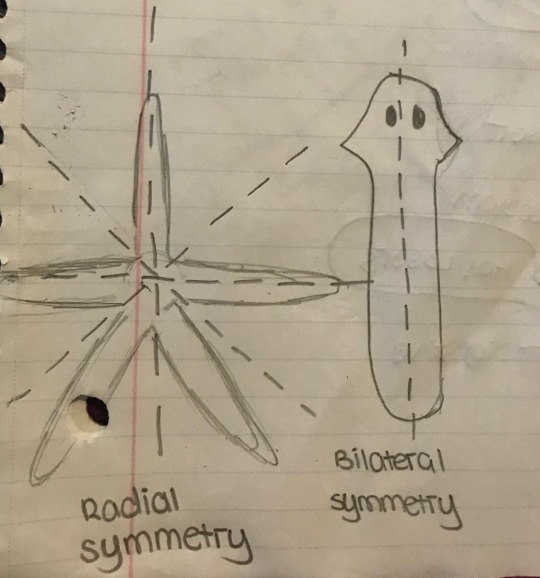
This also means that Patrick Star is not drawn biologically accurate. Shame.

Body Cavity Formation
The coelom is a fluid-filled body cavity, completely surrounded by mesoderm tissue. It is found only in more evolutionarily advanced organisms. Organisms like flatworms, who lack a coelom are known as acoelomates. Organisms, like nematodes or roundworms, who have a fluid-filled tube between the endoderm and mesoderm, functioning as a hydrostatic skeleton, are known as pseudocoelomates. Coelomates are organisms with a true coelom. Annelida, Mollusca, Arthropoda, and Chordata are all phyla that have this structure.
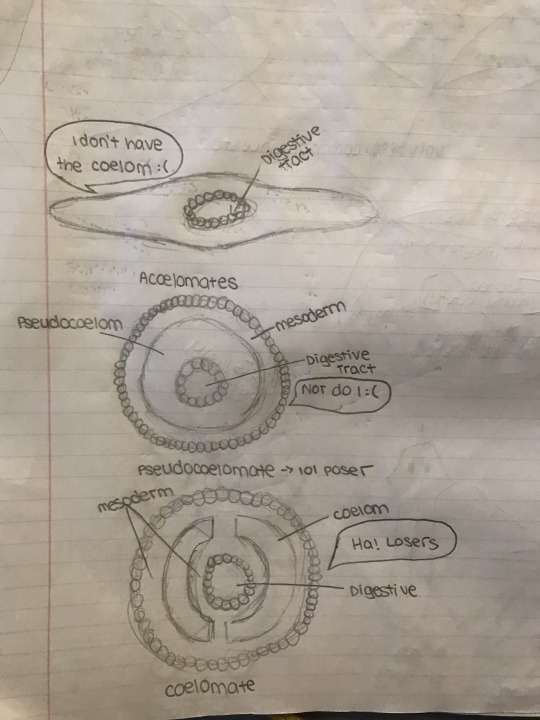
Development of a Head (Cephilization)
Organisms that developed bilateral symmetry also have an anterior and posterior end. (The head and rear end). The sensory apparatus and brain, or ganglia in less developed organisms are organized on the anterior end, while digestion, excretion, and reproduction all keep their organs on the posterior end. Cephilization began with flatworms.
Here is a cladogram to help visualize when different traits developed.
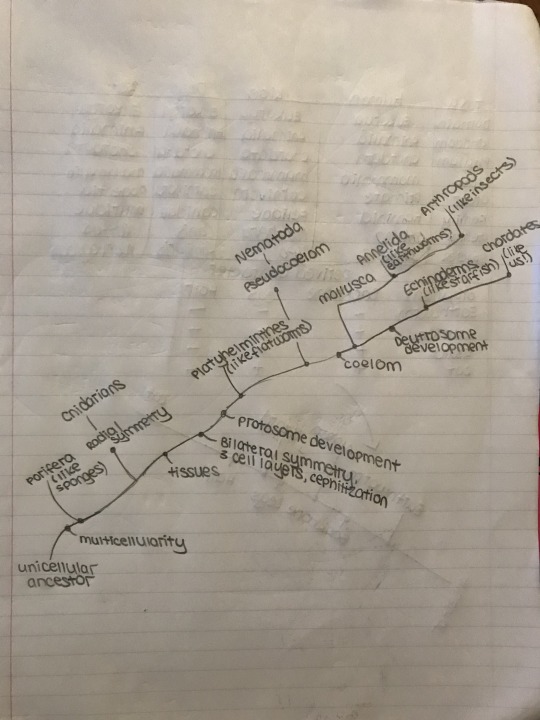
Traits of 9 different phyla:
Porifera:
No symmetry at all
No nerve or muscle tissue, sessile (nonmotile)
Filter nutrients from water drawn into a central cavity
Like many other primitive organisms, they only have 2 cell layers, ectoderm and endoderm, with the noncellular mesoglea holding them together
They have specialized cells, however, there is no organization to the cells, therefore they do not have tissue or organs.
Evolved from colonial organisms: fun fact, you can push a sponge through a cheesecloth, which will separate into individual cells, all and become a sponge. This is related to how a sponge reproduces
They reproduce asexually via fragmentation, meaning each piece that is separated has the necessary cells to become an individual organism. This means that technically,
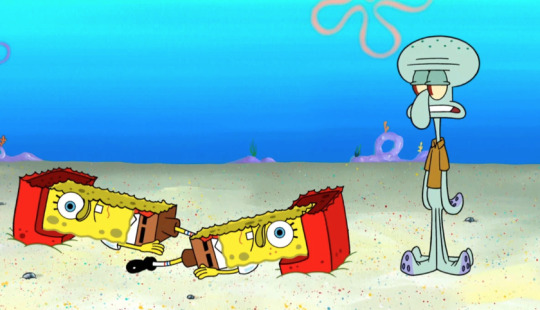
Spongebob is reproducing here. Good on him.
They also reproduce sexually. They are hermaphrodites, meaning that they have characteristics of both males and females.
Cnidarians
Include organisms like hydra and jellyfish
Radial symmetry
Body plan is a polyp (vase-shaped, like hydra) which is mostly sessile or medusa (upside-down bowl-shaped, like jellyfish) which is mostly motile.
Life cycle- although there are exceptions, some go through a planula larva (free-swimming) stage, then proceed to their reproductive stage, that being asexual (polyps, ) or sexual (medusas)
Only have ectoderm and endoderm cell layers
Have a gastrovascular cavity where extracellular digestion occurs. They only have one opening to this cavity, so waste and food both go through the mouth.
Have lysosomes where intracellular digestion occurs.
No transport system, since each cell is in contact with the outside environment.
All have stinging cells (cnidocytes) for protection, with nematocysts, which are stingers.
Platyhelminthes
Include organisms like flatworms like tapeworms
These are the most simple organisms with bilateral symmetry, an anterior end, and 3 distinct cell layers (ectoderm, endoderm, and mesoderm... yay bones muscle and blood!)
The digestive cavity has only 1 opening for egestion and ingestion, like cnidaria, so food can’t be continuously processed.
Their body is solid and has no room for a true digestive and respiratory system to circulate food or oxygen. The solution to this problem was to develop an extremely flat and thin body that allowed most of their body cells to have contact with the outside and thus exchange nutrients and waste via diffusion.
Nematodes
Include roundworms like pinworms
Unsegmented worms with bilateral symmetry, but very little sensory apparatus.
A large majority of them are parasitic. Trichinosis is caused by the worm Trichinella, which is often found in uncooked pork.
C. elegans is often used as an animal model when studying genes and embryonic development.
Digestive tract is two way, meaning they have a mouth and an anus
Annelids
Include earthworms and leeches
Segmented worms with bilateral symmetry, and very little sensory apparatus.
Two-way digestive tract, and a tube within a tube, consisting of a crop, gizzard, and intestine.
They have a nephridium, which is a tubule responsible for the excretion of nitrogen waste, urea.
They have a closed circulatory system and a heart with 5 pairs of aortic arches
Diffuse oxygen and carbon dioxide through their moist skin
Hermaphrodites
Mollusca
Include squids, octopi, slugs, clams and snails.
Have soft bodies, protected by hard calcium shells
They have open circulatory systems. This means they don’t have capillaries, however, have blood-filled spaces called hemocoels, or sinuses.
Have bilateral symmetry and 3 distinct body zones: The head-foot, with sensory and motor organs, Visceral mass, with organs of digestion, excretion, and reproduction, and the mantle, a specialized tissue that surrounds the visceral mass and produces the shell.
They have something known as a radula, which is moveable and has teeth, that behaves like a tongue.
Many have gills and nephridia
Arthropods
Include insecta (like grasshoppers), crustacea (like shrimp and crabs), and arachnida (like spiders and scorpions
Have jointed appendages
Segmented into head, thorax, and abdomen
Contain more sensory apparatuses than annelids which means they can move much more freely
Have an exoskeleton made of a polysaccharide known as chitin.
They also have an open circulatory system, with a tubular hard and hemocoels
For excretion, they have structures known as Malpighian tubules, which remove the nitrogenous waste; uric acid.
They have air ducts known as trachea which bring air from the environment into hemocoels.
Echinoderms
Include sea stars and sea urchins.
Most are sessile, or slow-moving (so stop judging Patrick. It’s just how he was born)
They are an exception to the bilateral symmetry rule. As embryos, they have bilateral symmetry, however, as they develop, they develop radial symmetry. This evolved for their sedentary lifestyle.
They have a water vascular system, which creates hydrostatic support for their tube feet which allow for locomotion
They reproduce sexually via external fertilization
They also have the ability to reproduce asexually via fragmentation, and regeneration. As long as the new sea star has part of the central canal, it will become a new organism.
They have an endoskeleton with calcium plates. Endoskeletons grow with the body, as opposed to exoskeletons that have to be shed
Chordates
Include vertebrae (like us!)
Chordates have a notochord which is a rod that extends the length of the body and is a flexible axis.
They have a dorsal, hollow nerve cord
The tail is responsible for movement and balance. We, humans, have a coccyx, which is a vestige of what was once our tail. Hence the name, tailbone.
Birds and mammals are homeotherms, meaning they are able to maintain consistent body temperature. The other chordates, like fish, reptiles, and amphibians are cold-blooded.
Let’s get specific, with mammals (because mammals are a superior class of animals. I would know, I am one.)
Mammals are named after their mammary glands. These glands let mothers provide milk to their babies.
They all have hair or fur
They are endotherms, meaning they generate their hair from within
Most are placental mammals, also known as eutherians. The embryo develops internally in a uterus connected to the mother via a placenta. Since the embryo is unable to perform essential functions such as digestion and excretion by itself, until late into the pregnancy, the placenta diffuses nutrients in and waste out for the baby.
Marsupials are an interesting class of animals. Their babies are born extremely early in development (after about 36 days), however, the mother has a pouch, where the baby will nurse until around 9 months.
Most mammals give birth to live young. There are exceptions to this rule, as our favourite egg-laying mammal of action’s theme explained to us. (Dooby dooby dooa dooby dooby dooaa AGENT P!)
Platypi and spiny anteaters derive their nutrients from a shelled egg.
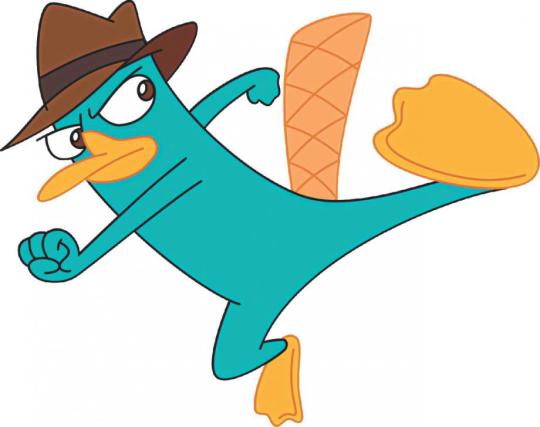
Getting even more specific, let’s talk about primates. These are the least superior mammals. I should know. I am one.
Primates were descendants of insectivores. They have dexterous hands, and opposable thumbs, which allow their hands to perform fine motor tasks. Instead of claws, they have nails
Their hands contain many nerve endings, making them very sensitive (which is why papercuts are so agonizingly painful.) Their eyes are forward-facing and close together. This allows face to face communication. Close eyes allow for overlapping fields of vision, increasing depth perception and hand-eye coordination.)
Primates engage in the most intensive parenting out of any mammal. They tend to have single births and build strong bonds with their young.
The book organized 3 different organisms based on their taxonomy. I put that down and added rats because rats are cool. Don’t @ me.
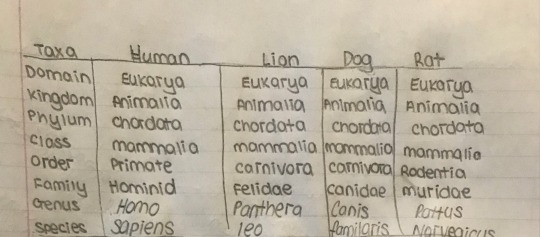
Cladograms
Cladograms are an extremely useful tool to show how organisms evolved different traits over time. There is a more complicated one above, however, the book included an extremely simplified one also that helped me understand how these graphs are made, so I will include that here as well.
First, like any graph, a table is made detailing the data that will be graphed. In this case, this data will be the specific organisms (cats, lizards, salmons, and earthworms) and the existence of specific traits (backbone, legs, and hair.)
Then a line is drawn, showing each trait as it developed, following by the organism with that trait.
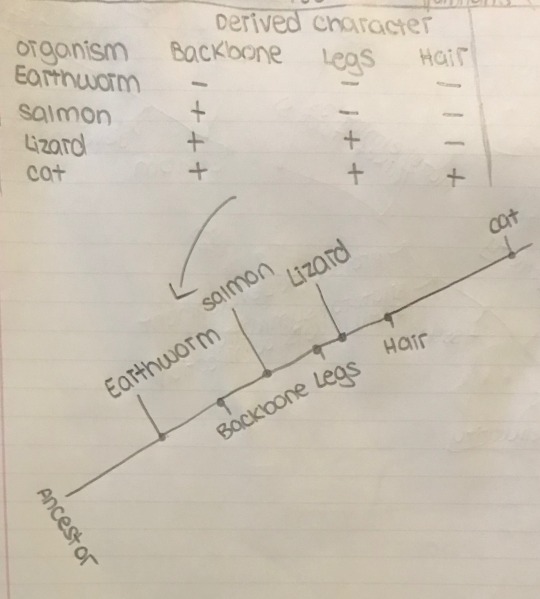
What this graph shows is that cats and lizards are more related than lizards and earthworms, etc. Tldr; a cladogram/phylogenetic tree draws distinctions between shared traits (traits different organisms have in common) and derived traits (traits that the ancestor did not have) displayed in such a way so as to show the evolutionary history of a group of organisms.
So what qualifies an animal? Animals are multicellular eukaryotes. They are all heterotrophs, meaning they acquire nutrients via ingestion. (Unlike plants, which manage to get nutrients through photosynthesis, such as the Calvin Cycle which produces a plants sugar.) All animals can move in some form.
Movement is a broad term. Beating cilia, and waving tentacles both count as movement. The movement that often comes to peoples minds, however, is locomotion, which is the movement from place to place. Some animals are sessile, which means they lack the capability to move from place to place. Hydra can still wave their tentacles (in the air like they just don’t care). Sponges are an interesting case, as many legitimately, cannot move.
Above, I mentioned terms like endoskeletons, exoskeletons, and hydrostatic skeletons. Hydrostatic skeletons are closed body compartments filled with fluid, that provide support. Exoskeletons are external, nongrowing skeletons, made of chitin (which also makes up the cell walls of fungi). Endoskeletons are internal skeletons made of bone and cartilage that grow with the organism. They are connected to each other at joints via ligaments, and to skeletal muscles (voluntary muscles) via the tendons.
All life has the ability to maintain homeostasis. Life survives within a narrow temperature range, from around 0 degrees Celsius to around 50 degrees celsius. In the ocean, this was not a massive problem, as it is the most stable environment temperature-wise, as water is able to absorb a lot of heat. However, the land is a lot more crazy. Different organisms found different ways to adapt and survive.
For example, a jackrabbit's ears are a major tell about what climate they live in. Jackrabbits that survive in the cold have small ears to minimize heat loss. Jackrabbits living in the heat have large ears that allow heat to dissipate, filled with small capillaries making the ears appear pink.
Huddling, basking, panting and sweating, swarming, and shivering are all examples of adaptations different organisms use to survive in extreme temperature. Depending on whether an organism is an ectotherm or endotherm, their temperature regulation will be different. An ectotherm is heated from the outside. For example, crocodiles bask in the warm sun to heat their bodies up. Endotherms or homeotherms generate their heat from the inside by using large quantities of energy. For example, a litter of cold puppies will huddle together and with their mother, as their warmth, and their mothers warmth help heat them up.
Excretion refers to the removal of metabolic waste, such as excess water, carbon dioxide, and nitrogenous waste. There are 3 different kinds produced by different organisms
Ammonia
Ammonia is soluble in water and extremely toxic. Anybody who takes proper care of a fish tank is aware that cleaning the ammonia from their tank is essential in keeping their fish healthy.
Excreted mainly by marine life, like hydra and fish.
Urea
Not as toxic as ammonia
Excreted by earthworms and humans (urine contains urea and water)
In mammals, the liver is responsible for turning ammonia into urea.
Uric Acid
A paste-like substance that isn’t soluble, and not very toxic
Excreted by insects, many reptiles, and birds, and allow for the preservation of water.
Different organisms have different structures that allow for excretion.
Hydra excretes ammonia with no aid from any excess structure.
Platyhelminthes have flame cells that help them excrete ammonia
Earthworms have nephridia (metanephridia) to excrete Urea
Insects have Malpighian tubules to excrete uric acid
Humans have nephrons to excrete urea.
Following up, let's look at 3 different organisms and the characteristics that make them unique!
Hydra (from Cnidaria)
Hyrda digest their food in the gastrovascular cavity. They, unfortunately only have one hole, where food goes in and waste comes out. The gastrodermis (gastrovascular cavity lining, or gastrocoel) secrete digestive enzymes to help extracellular digestion progress. Lysosomes, which are found in animal cells are responsible for intracellular digestion.

Hydra reproduces asexually by budding. A bud is a genetically identical, but tiny little hydra that grows within or on the parent.
Earthworms (From Annelida)
The digestive system of earthworms is much more complex than that of the hydra. Luckily, they have a mouth and an anus. The mouth ingests decaying organic matter along with the soil. The food travels down the oesophagus into the crop. The crop stores the food until it is ready to be digested. The food then moves into the gizzard, with thick muscular walls that digest the food mechanically, with the aid of the ingested sand and soil. The food moves into the intestines, where chemical digestion occurs. The intestine has a large fold, called the typhlosole, which increases the surface area.

Worms don’t have a traditional respiratory system. Instead, gas is exchanged by diffusion, through moist skin. This type of respiratory system is called an external respiratory system. Their hearts have 5 aortic arches that pump blood. Worms have capillaries, giving them a closed circulatory system. Their blood contains haemoglobin, making it red. Earthworms have nephridia, excreting urea, and are hermaphrodites. A worms brain is made of two dorsal, solid, fused ganglia, with a solid, ventral, nerve cord.
Grasshoppers (From Arthropoda)
Grasshoppers also have a digestive tract consisting of a crop and gizzard. They also have mouthparts specialized for tasting, biting, and crushing food, and their gizzard has chitin plates that aid in mechanical digestion. Their digestive tract contains Malpighian tubules that remove nitrogenous waste in the form of uric acid. (No, I did not draw a grasshopper. I know when I am defeated.)
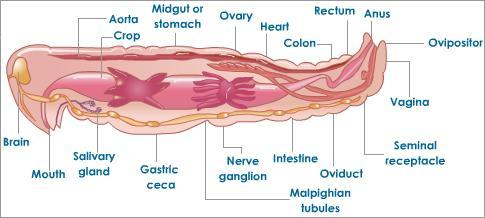
Grasshoppers have a similar nervous system to worms, however, they have an open circulatory system. They lack capillaries, and blood moves through hemocoels instead. Arthropod blood has no haemoglobin. They have an internal respiratory surface because gas exchange occurs on the inside. They have a system of tracheal tubes that lead to the hemocoels. Oxygen is carried by hemocyanin, with copper as the core atom. This is why molluscs and insects have blue blood.
#animals#animal physiology#physiology#biology#animal biology#bacteria#fungi#protists#archea#domains#phylum#taxonomy#platyhelminthes#annelids#porifera#nematodes#cnidaria#echinoderms#chordates#mollusca#arthropods#grasshopper#grasshopper biology#grasshopper physiology#hydra#hydra physiology#earthworms#earthworm physiology#SAT Bio#SAT biology
25 notes
·
View notes
Text
Dermatology Externship
My last 3 weeks have been a very rewarding experience. I got to work with the only dermatologist in the country who is double boarded! This was a lot of fun for me because I have been managing my own pet with environmentally induced atopic dermatitis for a couple years. It was nice to see that I have been doing some things right.
We worked 13 hour shifts and I had an 1.5 hour drive in both directions, but that’s the only thing I could possibly complain about on this one. I loved the mentorship and guidance I got while also having the freedom to determine how I want to practice medicine.
Things I learned
So many dogs have allergies. These tiny gene pools are forever ruined. Those bulldogs at shows don’t have normal skin and that’s what we’re making more of.
Allergies are not a disease we cure, but one we manage. Clients have the frustrating task of spending time and money to manage this disease. Please do not be mad at vets for this. We did not give your pets allergies.
An old dog who is suddenly itchy should make you think of ectoparasites before anything else
Please don’t keep sending your clients with antibiotics and steroids – especially without an exam! That is bad medicine at its core and I saw a lot of frustrated owners
Abscesses that have good drainage do not require antibiotics
For the love of Dog, if your patient has skin issues, then take skin impressions and actually look for yeast and bacteria. Do not just assume because they can look identical or have both at the same time.
You need to recheck skin patients. If problems are not resolving, resistance bacteria/yeast is possible
As a practitioner, you better make your notes legible. A medical record is a legal document. Trying to read chicken scratch is horrendous, but at least some of you actually wrote notes about your exams instead of just the prescriptions… I am still salty about this bit
Always make sure that your allergy testing lines up with your patient’s symptoms. Early spring itchies? Trees better be on there somewhere
Autoimmune skin diseases are rough
I got to see a case of feline progressive histiocytosis which was the bumpiest cat I have ever seen in my life. Probably will never see it for the rest of my career, but I successfully diagnosed one!
Clients are far less willing to work up allergies in a cat than in a dog, which is likely why I only got to see 6 of them on this rotation. Cats in general seem to have less value to clients than their dogs.
We have no idea what the ‘magic’ protein size is so that dogs/cats will not react to their food. AltAmino is currently the smallest on the market.
Zoonotic diseases are fun, aren’t they? I had one client who did not believe me that her dog had scabies and, uh, so did she. Plus her small children. That was fun.
I love derm. I got to take lots of biopsies and appreciate how few euthanasias are present in this line of work, but I have so much more that I want to do with my life. Sadly, I did have one patient euthanized on this rotation because his subcutaneous mast cell tumor won the fight and was making his life intolerable.
Up next is my anesthesia rotation!
#future dvm#vet student#vetblr#vet school#vet med#veterinary medicine#veterinary school#veterinary student#petblr#dermatology#veterinary dermatology#externship#6.5/8#summer 2019
23 notes
·
View notes
Text
How to Test for Mold Illness in Your Body
Do you have mold illness?
Check out my top recommended testing methods to find out, including:
Mold Toxicity Checklist
Mycotoxin Urine Test
Bloodwork
Gut Testing
Liver Function Testing
DUTCH Cortisol Hormone Test
Visual Contrast Sensitivity Testing
Mold Illness Refresher
Let’s briefly review Mold Illness 101 before diving into my top recommended tests to know what we are looking for in the first place.
Mold illness or “mycotoxin illness” is a serious condition that is commonly referred to as “CIRS”—Chronic Inflammatory Response Syndrome.
Unlike a disease—which is condition typically with a specific known cause and similar symptoms (such as insulin resistance, frequent urination and weight gain in people with diabetes)— a syndrome, like CIRS, is a much broader “collection of signs and symptoms” that may present differently in different people.
Signs & Symptoms of CIRS
Common signs and symptoms of mold illness or CIRS include
Respiratory difficulties (difficulty breathing, shortness of breath, asthma)
Neurological symptoms
Sinus congestion and stuffy nose
Hair loss
Anxiety
Brain fog, confusion or memory loss
Difficulty concentrating
Morning stiffness, joint pain
Light sensitivity
Skin rashes
Red eyes, blurred vision, sweats, mood swings, sharp pains
Feeling lightheaded or dizzy
Appetite swings
Poor body temperature regulation,
Gastrointestinal problems (cramps, abdominal pain)
Weight loss or weight gain (unintentional)
Unusual skin sensations, tingling and numbness
You may have several of these symptoms—or just one or two. The amount of symptoms don’t matter as much as the unrelenting poor health experienced because of them.
Although these symptoms are also synonymous with other conditions often talked about in functional medicine—from “adrenal fatigue”, thyroid disorders to gut dysbiosis—the key distinguisher in mycotoxin illness or CIRS is often times, these are often the patients who do not “get better” once commencing a protocol.
Buttttt….how do you know if you really have “mold illness” or CIRS—or you’re just feeling out of sorts? What tests can you do to reveal true illness
There are a handful…
Mold Toxicity Checklist
Aside from identifying your symptoms, answer “Yes” or “No” for the following questions (adapted from Environmental Health Center).
Yes or No?
Do musty odors bother you?
Have you worked or lived in a building where the air vents or ceiling tiles were discolored?
Have you noticed water damage or discoloration elsewhere?
Has your home been flooded?
Have you had leaks in the roof?
Do you experience unusual shortness of breath?
Do you experience recurring sinus infections?
Do you experience recurring respiratory infections and coughing?
Do you have frequent flu-like symptoms?
Do your symptoms worsen on rainy days?
Do you have frequent headaches?
Are you fatigued and have a skin rash?
If you answer “yes” to 4 or more, your CIRS-like symptoms may have some more merit.
Mycotoxin Urine Test
Mycotoxin urine testing is a relatively newer form of testing that can reveal the release of toxins in the urine. If you really suspect mycotoxin illness from molds to be at play, this test can yield highly insightful information for putting your puzzle together.
Some key detected mycotoxins include:
Ochratoxins
Aflatoxins
Trichothecenes
Glicotoxins
Recommendation:
Great Plains Urine Testing (Order Here on behalf of Dr. Lauryn Lax, OTD).
*Note: Sometimes false “negatives” can occur with urine testing since some patients are unable to detoxify in the first place. In order to get the most accurate results, I recommend using high dose glutathione + NAC for 5 to 7 days prior to conducting your urine test in order to encourage elimination and detoxification.
My preferred formula is Trizomal Glutathione by Apex Energetics, which includes both NAC and glutathione. Take 1 tsp 3 times per day for 5 to 7 days. It is tough to find online, but if you call the company directly at 949-251-0152, request a bottle be sent to you on behalf of Dr. Lauryn Lax.
Bloodwork
Bloodwork doesn’t always tell the whole story of CIRS or mycotoxin illness, but certainly can point to markers of inflammation and immune dysregulation.
Unfortunately, many patients consult with their conventional medical practitioners and are told, “Your lab tests are normal”, but have not ordered more specialized tests that help look deeper into mycotoxicity and inflammation. Helpful markers and their normal ranges for assessing mycotoxin illness include:
Specialty Mycotoxin Blood Tests
Elevations in the following markers point to mold toxicity
VIP (normal range: 23-63, only available by ARUP Labs)
MSH (normal: 35-81)
MMP-9 (normal: 85-332)
C4a (normal: 0-2380)
TGF-beta-1 (normal: <2380)
Leptin (Male: 0.5-13.8; Female: 1.1-27.5)
HLA-DR (the gene that 25% of the population has, making them more susceptible to mycotoxicity; can only be run by LabCorp)
OTHER LABS
Other labs that may be “off” on general lab work include:
Complete Blood Count
Red Blood Count low (normal: 4.40–4.90 x 106/µL)
White Blood Count low or high (normal: 5.0–0 x 103/µL)
Methylation Markers
MMA high (ideal < 300 nmol/L)
Folate low (ideal > 8 μg/L)
Bloodsugar Markers
Glucose low or high (normal fasting: 75-85, normal 1-2 hours post-meal: 110-140)
HgbA1C high (normal 4.6–5.3%)
Liver Enzymes
AST high (normal: Male: 0–25 IU/L; Female: 0–23 IU/L)
ALT high (normal: Male: 0–26 IU/L; Female: 0–20 IU/L)
Nutrient Markers*
Zinc (often low)* (normal: 81–157 µg/dL)
Copper* often high (excess copper can lead to low zinc) (normal: 81–157 µg/dL)
Iron high or low (ideal: 40–135 µg/dL)
Ferritin high (Male: 30–200 ng/mL; Female: 30–100 ng/mL)
Vitamin D low (normal: 35–60 ng/mL)
*Urine testing via NutraEval (Order Here and search for “NutraEval FMV by Genova)
Inflammatory Markers
Total Cholesterol high (normal: 150–220 mg/dL for males; 150–230 mg/dL for females)
LDL Cholesterol high (normal: 0–140 mg/dL)
C Reactive Protein (CRP) high (normal: 0–1 mg/L)
BUN high or low (normal: 13–18 mg/dL)
Creatine low (normal: Male: 0.85–1.1 mg/dL; Female: 0.7 – 1.0 mg/dL)
Hormone Markers*
*Hormone markers can be a sign that something more is going on “under the hood.” Inflammation from mold toxicity and CIRS can drive hormone imbalance. Since hormones are the “key messengers” made by our glands to regulate body functions, if our hormones are “off”, they may perpetuate the symptoms of CIRS.
PTH elevation (normal: 10-35 pg/mL
T3 (Thyroid Hormone) deficiency (normal: 2.5–4.0 pg/mL)
Testosterone deficiency
Progesterone deficiency
Estrogen dominance or deficiency
Bloodwork out of the norm in several of these areas may indicate imbalance.
Gut Testing
A bi-directional relationship exists between mycotoxins and gut microbiome—mycotoxicity can impact and worsen our gut health, just like poor gut health can make one more susceptible to mycotoxicosis (1)—creating the “perfect” storm.
On this note, it’s critical to realize, “mold illness” does not just happen from mold alone. Other pathogens that cause the same symptoms as mold illness include:
Bacteria & bacterial infections (like Babesia and Borrelia)
Fungi
Mycobacteria
Mold
Mold spores
Endotoxins (aka lipopolysaccharides, or LPS; cell wall components of gram-negative bacteria)
Inflammagens (irritants that cause inflammation and edema)
Beta-glucans (sugars that are found in the cell walls of bacteria, fungi, yeasts, algae, lichens, and plants)
Hemolysins (toxins produced by bacteria that can destroy cells)
Volatile organic compounds
The key theme behind all of these? They affect your gut!
Your gut microbiome is home to 100 trillion microorganisms (gut bacteria). The healthier your gut bacteria, the healthier you are! The sicker or more pathogenic your gut bacteria, the sicker you are!
It’s no wonder that candida (fungal overgrowth) and sinus congestion (from fungi and mold growth in the nose—part of the nasal microbiome) are common in those with suspected mold toxicity or CIRS (2).
Given that approximately 80% of your immune system is produced and housed in your gut, a “strong” gut filled with diverse, healthy gut bacteria helps boost your immune fighting defenses to weather the storm of mold and mycotoxin exposure. However, if your gut is infiltrated by pathogens—and not enough “man power” to weather the storm, eventually your gut microbiome profile can shift, resulting in an unhealthier gut…and an unhealthier you.
Recommendation:
Comprehensive Stool Analysis + Parasitology x 3 (Doctor’s Data) (Order Here)
Liver Testing & Symptom Checklist
In addition to your gut, your liver—your body’s “chemical processing factory” and recycling system—also plays an important role in guarding against mycotoxin and mold illness. Consider your liver your “defense” for mycotoxin and mold exposure. A sluggish or overworked liver can equally wreak havoc on your health and make you susceptible to mycotoxin illness
Liver Checklist
The best way to assess for liver dysfunction is a combination of blood markers and symptoms. Common liver malfunction indicators include:
Nausea
Sensitive to chemicals (perfuma, cleaning agents, etc.)
Bitter/metallic taste in mouth
Headache over the eyes
Easily motion sick
Itchy skin
Jaundice colored skin/eyes
Swelling (abdomen, legs, ankles)
Light or clay colored stools
Greasy or shiny stools
Constipation
Easily intoxicated
Hormone imbalances (PMS, PMDD, irregular menses)
Glucose/blood sugar imbalances (hypoglycemia in particular)
Brain fog
Nutrasweet/artificial sweetener consumption
History of antibiotics, birth control or long term medications
Liver Function Blood Markers
ALT: High
AST: High
GGT: High
LDH: High
Alkaline Phosphatase: High
Cortisol Hormone Testing
Your CNS (central nervous system) is your “stress response system.” When functioning properly, your body is able to overcome stress. If malfunctioning, chronic illness and uncontrolled inflammation happens. Swelling of the brain and “stress response” system can lead to changes in nerve endings and interfere with the electrical signaling to all functions of the body. Enter: The unrelenting CIRS symptoms that persist for those who suffer from mycotoxin illness.
Cortisol hormone testing can give you a clearer picture of where your “stress hormones” are at, along with neurotransmitter function that play a role in controlling inflammation and stress in the body as well—such as dopamine and serotonin.
Note: NOT all hormone testing is created equal. While bloodwork is great for assessing sex hormones (estrogen, progesterone, testosterone), it is not great at cortisol testing.
Cortisol is a constantly changing hormone throughout the day. Therefore you need to collect multiple samples in a given day via urine and saliva in order to see an accurate pattern for your body. In addition, not all urine and saliva tests are created equal! Most tests measure either one or the other—leaving you with only partial results. Most tests also only measure “free cortisol”—NOT metabolized cortisol. However, free cortisol only makes up less than 3% of all cortisol in your body.
For these reasons, to date, the gold standard for cortisol hormone testing is the DUTCH test—which uses both urine and saliva testing, and measures both free and metabolized cortisol.
Recommendation:
DUTCH Cortisol Hormone Testing (Order Here)
Visual Contrast Sensitivity Test
Dr. Ritchie Shoemaker, creator of SurvivingMold.com and a “father” of mold toxicity recovery invented the “Visual Contrast Sensitivity” test to measure of one of the neurologic functions of vision called contrast.
In his years of work with patients recovering from mycotoxin illness, Dr. Shoemaker realized a key theme his patients shared was poor “contrast sensitivity” in their vision.
His online test can help individuals further identify potential exposure to neurotoxins, biotoxins, and nutritional deficiencies in the body. These compounds have been implicated in diseases such as ADHD, CFIDS, fibromyalgia, mold illness, and Lyme disease.
It’s not the “end all, be all”, but can be part of a comprehensive work up.
Beyond Testing
While testing can be a helpful piece of the puzzle to identifying and confirming CIRS and mycotoxin illness, it’s vital to remember, testing is not the “end all, be all.”
As a functional medicine practitioner, I treat and empower individuals based on the person, not the numbers, and if empirical findings—such as your symptoms or lack of health improvement despite “doing all the things” (i.e. eating clean, working out, sleeping) are still present, then it is safe to assume that something is not right “under the hood.”
Check out the next post on my top ways to “treat” for mold and get rid of it! (So you can get on with your full, amazing life).
References
Winnie Pui Pui, Liew & Sabran, Mohd Redzwan. (2018). Mycotoxin: Its Impact on Gut Health and Microbiota. Frontiers in Cellular and Infection Microbiology. 8. 10.3389/fcimb.2018.00060.
Brewer JH, Thrasher JD, Hooper D. Chronic illness associated with mold and mycotoxins: is naso-sinus fungal biofilm the culprit? Toxins (Basel). 2013 Dec 24;6(1):66-80. doi: 10.3390/toxins6010066. PubMed PMID: 24368325; PubMed Central PMCID: PMC3920250.
The post How to Test for Mold Illness in Your Body appeared first on Meet Dr. Lauryn.
Source/Repost=>
https://drlauryn.com/wellness-knowledge/how-to-test-for-mold-illness/ ** Dr. Lauryn Lax __Nutrition. Therapy. Functional Medicine ** https://drlauryn.com/
5 notes
·
View notes
Text
As some of you following this mess of a blog may have noticed, I'm getting myself a puppy. Actualy, it's more of a late birthday present from my parents, but the point stays the same - soon, there's going to be a small furry creature by my side and since it will be my responsibility to raise and care about it, instead of surprising me with an actual fluff ball out of the blue, mom and dad let me chose the pup on my own.
Naturally, at some point it became a topic between my coleagues and me during work break yesterday, which is a reason why I am writing this long post right now (sorry but not sorry). I want to talk about this, because some of things about dog raising said people mentioned made me stare at them in disbelief while other made me hopelessly sad and angry. Me. A normal person. Someone who never studied dog psychology or kynology or training methods in any serious way other than reading a few books and stuff on net out of curiosity. I probably can't even imagine what an expert would think about all that nasty stuff I heard from them!
So let me tell you one thing - common people (the ones I talked to at least), even those who currently own a dog or owned one in past, have prety much ZERO IDEA and also ZERO WILL TO LEARN about how to chose the right dog and how to rise it properly! Their whole thinking process when it comes to dogs can be sumarised into - wild puppy appears. Puppy uses cute eyes. It's supereffective. Puppy is now theirs. They put it on a leash or chain. They feed it once a day and get angry when it barks and destroys things. The end.
Like... excuse me?!
In this essay I will...
But seriously. If you think about getting yourself a dog but have no idea how to go around it or you know of someone in such situation who needs a bit of an advice, in this post I will give you all a few tips about chosing process I learned both from getting our previous family dogs and by googling around for hours (not kidding, I've been excessively searching for informations ever since that birthday gift puppy talk I had with my parents).
I hope that this post may help you with chosing just the right dog for you. Or at least it may give you some ideas about which questions to ask yourself and what to look for and think about before you bring a new puppy to your home.
And no, I don't mean questions such as "how big of a dog do I want" or "what and how much does it eat" or "do I have time to take it for a walk everyday" or "should I get a female or male, neutered or not" etc. I believe that you already asked yourself those and you know your answers or have at least some vague idea about what your future dog should or shouldn't be like.
What you probably DIDN'T think to ask yourself or your family members (those guys I talked to before definitely didn't from what I understood) can be put into following categories:
- possible genetic defects and predispositions to hereditary deseases associated with specific dog breeds
- common or seasonal illnesses and health risks associated with dogs body type
- comfortable temperature range for the dog
- intelligence, trainability, temperament etc
- hair and skin care, shedding, grooming difficulty
- background and personal history of specific dog
So let's start with the least funny topic of those and that is INBORN DEFECTS AND HEREDITARY DESEASES
To understand why they are such an issue, especialy in relatively young or modern, recently fixed breeds which origins can be tracked down to just a small number of dogs, you have to realize that the natural form of a dog is a wolf. Size may differ and so can fur lenght, quality and colour, but the shape stays more or less the same - long slim legs with well defined fingers, long wrinkless nose, long slim neck, relatively small standing ears, solid muscular body fully covered in fur. Examples of dog breeds with similar traits include but are not limited to german or belgian shepperds, russian laika and all basic schpitz types of dogs starting with tiny pomeranian and ending with eskimo dog. The less of those traits you find in a dog the more prone to hereditary deseases the said dog breed is for one simple reason - selective breeding.
Older breeds have somewhat of an advantage. They developed over longer time from possibly hundreds maybe thousands of original dogs with different atributes. Mountain breeds turned to be thick coated because short haired dogs simply died during winter. People in areas with a lot of rodents and weasles preffered dogs of smaller sizes to hunt them down. Whether they were terrier, pinch or dachshund shaped, people didn't care as long as rats were gone.
As such, old breeds draw from richer starting genetic pool with less strict breeding oversight in early breed forming stage (this may have changed later and turn towards inbreeding tendencies but it's not a rule) which makes expression of hereditary deseases less likely (this still doesn't mean they have zero, mind you). For the same reason, dog mixes comming from different backgrounds such as half breeds or multiple breeds bastards are, generally speaking, healthier than pure breeds. More genes to draw from means lesser chance of two faulty alellas of same gene meeting in the same animal and expressing itself as a physical flaw or degeneration.
Compared to that, as an example, after a serie of genetic tests on modern pug population in UK, whole breed was tracked back to only aproximately 50 original ancestors. Basicaly, this means that if you compare two dogs whose closest common relative was their grangrangranmother 5 generations ago, chances are that, geneticaly speaking, they are still an equivalent to first cousins because the whole population is just so much inbred.
By this I don't mean to say that you shouldn't get a pug puppy and that pugs are the root of all evil just because of their past of inbreeding. What I'm saying is that before you bring your new pug home, you should do some research about breed's hereditary health issues and predispositions for such and ask yourself - are you prepared for an option that at some point your beloved pet may need an expensive eye surgery? Are you sure you have enough money to pay vet for threating dogs breathing difficulties, allergies and infections connected to its deformed snout (because let's speak openly, dog breeding, especialy when it comes to decorative and companion breeds, is all about active propagations of deformations for the sake of aesthetics, health issues be damned), possibly for a bigger part of their life? Are you prepared to take care of them in case they become partialy paralized due to hip joints deformation in older age?
If your answers are yes, then sure, get yourself a pug. Or bullterrier. Or cavalier king charles spaniel or any similarly inbred dog. If not, then chose a different breed with less potential for inborn defects. Keep in mind that just because the dog meets its breeds standards it doesn't mean those standards are 100% healthy to begin with. Even if the dog is fine right now, it doesn't have to stay that way forever. Use google. Do the math. And take your time chosing.
Next set of questions you should ask and find answers to is about health too, but this time they have less to do with genetics and more to do with BODY TYPE, SIZE AND SHAPE.
A quick overview:
Gigantic breeds tend to have problems with joints and bones, they also have shorter lifespans (french mastif, great dane and irish wolfhund live for only about 7 years. For a comparission, the oldest documented dog is lhasa apso. It lived fir 29 years).
Wrinkled breeds and breeds with excesive skin on head and around mouth or neck have higher risk of getting exema, yeast infection or mites in their skin folds. Combine it with long fur and you can count on antibiotics and/or antiseptic shampoo or powder prety much every rainy season. To add to this, shar-pei are also prone to skin overgrowth where folds may reach such a size that they obscure dogs sight and have to be removed by basicaly dog face lifting surgery. Accidental lip bites and mouth infections are also a thing when it comes to breeds with a lot of skin. Oh, and if such infection lasts for a long time or repeats often there's a high chance of dogs teeth getting infected and falling out as a result. So yeah.
Dogs with long or floppy ears can have a huge problems too. If combined with long fur of spaniel breeds for example, be prepared for seasonal ear infections and exema due to high temperature and humidity which has nowhere to go because of all that hair (we had american cockerspaniel and when she turned 8 she became fully deaf because of this despite my family treating her ears with cleaning drops and antibiotic solutions daily). And don't even get me started about grass seeds stuck in auditory canal. We had to see veterinarian to take those out at least once a week every summer. Also, there will be pieces of food stuck to hair and prepare for puddles of water around the bowl every time they drink too. Fun stuff.
Combine long ears with short legs of basset hounds for example and you get a lot of scratched and accidentaly pierced earlobes by their own claws when they run around and trip over them. It happens more often than you think.
Also about grass seeds and those hard thistle hooks, stabbed between fingers or paw pads, it's prety much impossible to spot them by eye on long haired breeds and you have to search for them by masaging between fingers and pads with your fingers daily during grass and thistle season. If you see a dog biting and licking it's paw, it's either stuck rock, long fur tangled into hard dirty fur ball that needs to be cut off from between its fingers or grass seed.
The list continues. Consider yourself warned.
Another set of questions you should ask is about TEMPERATURE RANGE in your area and is basicaly just about using your common sense.
No matter how charming you find them, for the sake of the dog's well being, please, don't get yourself an alaskan malamute if you live in Florida. And don't expect hungarian vizsla to survive winter in Rocky mountains sleeping outside in dog house either. Use that brain of yours a bit, I'm begging you! (One of my coworkers doesn't understand that dalmatian is NOT a dog suited for living outside whole year around, especialy in those -23°C night drops we get in february. Like excuse me? Poor creature doesn't have the undercoat for that kind of weather!)
INTELLIGENCE AND TEMPERAMENT
This part is easy. Ask yourself what kind of dog you want to own. Flegmatic feet warmer? The one you can take for a jog with you every morning? Agile fast learner for active fun such as freesbee or dog dancing? Childs nanny with a lot of patience around toddlers? A house guardian?
Some breeds are good for more than one thing, some are bred with specific personality in mind. For example - you can't turn border collie into your slow granma's lap warmer she can brush every day for hours, there's shih tzu for that, among other. But what you CAN do with a collie is to have it trained to pick said grandma's fallen walking stick, to bring her ringing phone or to bark if she forgets to turn off gas in kitchen. Remember - there's many many breeds with many different personalities and talents to chose from. Take your time picking.
Also, the saying that dog copies its owner is true. Even one of the calmest breeds - labrador retriever - can turn into a vicious biting beast if raised in disfunctional household. And with a patience and kind treatment, czechoslovakian wolfdogs can be as sweet as sugar.
However, one can't go against dogs predominant behavioral patterns, only along them. Jack russell terriers will be fast and easily excited whether you like it or not. Just because they are trained it doesn't mean they also magicaly lose their natural temperament. Remember that if you chose to get yourself a rat hunter you get yourself a rat speed, agility and seemingly endless energy. And since having a bored dog means having a destructive dog, imagine multiplying that destructive potencial with dogs activity and intelligence level. You don't like where this is going? Your dog, your problem. Chose the breed wisely.
If you still don't have any idea where to start, there's a cheat sheet in form of Stanley Coren's Dog intelligence chart. Naturally, higher on scale - easier to train. Check it out, guys. It may give you some interesting breed choices to consider.
Another category of questions you should answer to yourself before getting a dog is HAIR AND GROOMING related.
Dogs shed. Some all the time, some only once or twice per year. Some hair, despite being short and supposedly easy to care for while on dog in question, is a bitch to get out of clothes and carpets. Meanwhile other hair is so light and silky it floats around if you only as much as think about it, but if let untreatef there's a small dog worth of it everywhere all the time.
There are also exotic fur type options such as komondor or puli dog with natural dreadlocks or hairless xolo from Mexico.
Depending on your choice be prepared to spend anything from one week of seasonal blowout for akita inu or malamut to daily brush of lhasa apso. Either you make the time for grooming it yourself or you pay for it in dog saloon but one way or another, the hair is there and something has to be done about it. Again - your dog, your choice. Just be sure you know what you are getting into. Use that damned google or ask other dog owners about their grooming routine.
Another thing to keep in mind when it comes to fur is whether or not you can get your dog wet. Some breeds with thick fur may take too long to dry on their own which may result in pneumonia in cold weather or yeast infection, mites and exemas in hot temperatures. Don't bath those kinds of dogs unless it's realy necessary and be prepared to invest into dog rain coat and right grooming tools. Or, have them buzzed regularly.
But then again, WHY in the hell would you get yourself a long haired breed if you cut its beautiful mane to 5mm nonsense every month?! I've seen this done to ALL yorkshire and west white terriers in my town without exception. Like... what the hell? If you guys want a small terrier but you are too lazy to brush that long fur regularly then just get yourself border or jack russel terriers to begin with! I mean, the whole point of having a yorkie or westie is the trademark long fur goddamnit!
Oh and about cool fur (I almost forgot to mention this) there's rhodesian ridgeback whose back hair grows the other way! Check it out!
The last of important things you should consider before bringing a new dog home is its BACKGROUND AND PERSONAL HISTORY of the dog
This is especialy important if you are getting an adult dog or a dog from shelter.
Just as humans have their habits and past traumas, dogs have their own too. Aside from obvious problems connected to initial changes of dogs environment and/or lifestyle after transfer, dogs with the past of abuse may pull you into a whole lot of difficult situations.
They may be unusualy agresive or shy or scaredy or whatever compared to other dogs of the same breed (or multiple breeds if they are mixed) or they may act perfectly normal until triggered by something specific and behave in unexpected way when distressed.
We had such a problem with our retriever x boxer x german shepperd mix when she first came to us. She was all nice and friendly untill anyone, be it a family member or stranger, picked up a stick or rod. She had an abusive first owner who used to beat her using those, we think, and so sticks and other long slim items held in one hand turned into her stress trigger. My family was lucky that her first reaction was to flee and hide and as she grew to trust us the issue faded accordingly till it fully disappeared, but different dogs may act differently. Keep that in mind if you get yourself a rescuee.
Dogs which struggled with hunger in past tend to turn into glutons and may develop obesity and associated deseases if you don't keep their food intake in check. Those which came from households of alcoholics may react agresively to smell of alcoholic drinks. If the dog was tortured by nasty brats, it may attack children on sight. Et cetera et cetera.
So if you decided to get yourself a "second hand" pet, find out as much about that dogs past as possible. Hope for the best but be prepared for the worst advice has never been more true than when it comes to dogs comming from shelters.
Thank you for comming to my TED talk and feel free to add your own experiences and opinions
#dog#dogs#love dogs#dog breeds#how to chose#lhasa apso#shar pei#malamute#german sheperd dog#golden retriever#pug#king charles spaniel#yorkshire terrier#westie#boxerdog#jack russell terrier#purebreed#mixed breed#and everything else
2 notes
·
View notes
Text
10 Men’s Hair Myths Debunked
Misinformation is dangerous. Whether you’re placing a bank-breaking gamble, or taking Google’s phrase because of it that the odd pain inside your left cripple is probably planning to eliminate you, making conclusions according to falsity can have significant repercussions.
The same moves for your hair. Blithely accept any and all advice people give a person – from washing your own hair every day to be able to never washing it again – as well as your barnet can suffer. Don’t let your hair fall victim to false claims; following information to telling follicular reality from fake news.
Plucking A Grey Hair Makes More Grow
A classic wives’ favourite, the thinking that forcibly yanking the 1st indications of ageing from your current head will simply speed upwards the process is seated in the misconception that will hair grows in the same way as the plant.
“If you break up a plant’s root, both stems mayflower, nevertheless plucking hair will perform just that [and nothing more], ” claims Iain Sallis, hair loss specialist and director in the Hairmedic clinic. “If you just split the hair at scalp level – and an individual doesn’t pluck the complete hair out – that will still grow, although not in multiples. ”
Given that one grey hair results in more to come, continuing to pluck them may not make you much to work with either. In the event, the silver’s spreading up leading, stop plucking and resolve to grey gracefully, or even touch up problem locations with a dedicated colouring.
Wearing Hats Make You Go Bald
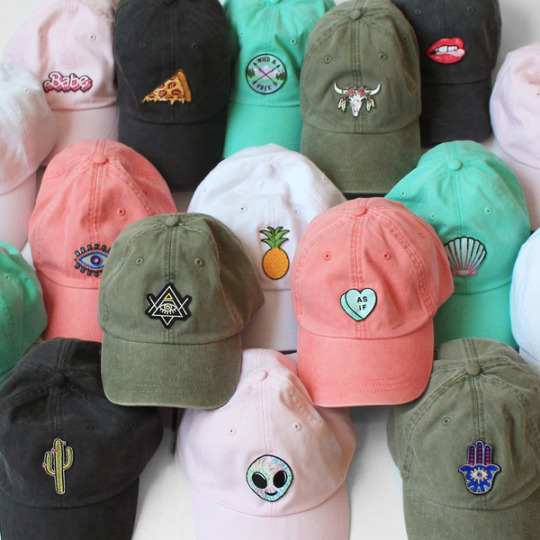
With this cranium-based cock and half truths story to be actually slightly true, your head wear will have to be tight adequate to cut off circulation to the follicles, in which often case you’d probably end up being too passed out to be able to care.
But that comfortable new snapback doesn’t appear without risks. “Hats don’t cause baldness but putting on one every single day can lead to hair breakage and damage because of typically the continuous pressure being put on the strands, ” says Chris Ward, proprietor of Huckle The Herrefris.
So while you’re totally free to shop this season’s selection of baseball caps, remember to give your brain a break every as soon as in a while, in addition to make sure it is located on, not strangles, your skull.
Dandruff Is Just Dry Scalp
Consider snowy shoulders are caused by a thirsty remaining hair? Think again. One of the many uncomfortable body problems men encounter, dandruff is often wrong for dry scalp because the symptoms of the a couple of conditions are similar ~ but they’re different.
“Scientists believe dandruff is brought on by a yeast disproportion inside the skin, ” claims Sallis. “We all have got yeasts on our remaining hair, but one out of particular ~ known as Malassezia furfur – can proliferate and trigger an inflammatory reply in the skin. This specific causes the topmost coating of the skin to cleave off erratically, major to the white flakes you see in your hair and clothes. ”
Dandruff won’t be eased simply by drinking more water plus knocking back cod lean meats oil capsules, so try out a mild antifungal hair shampoo designed to irradicate the particular associated symptoms and depart your scalp calm plus fresh.
Hair Needs To Be Shampooed Daily To Keep It Clean
Within a world almost comically enthusiastic about cleanliness, you’d be pardoned for thinking your mop requires daily cleansing. Nevertheless just like that industrial-sized bottle of hand sanitiser your hypochondriac colleague carries around, it could be doing more harm as compared to good.
“Everybody’s hair generates oils at different prices, ” says Denis Robinson, creative director at barbershop mini-chain Ruffians. “You should wash your hair when you feel it’s beginning to get greasy – regarding some people that may be everyday, for others it may be up to a week. ”
To absorb oil, harmful particles and product build-up inside a pinch, turn to be able to dry shampoo. But seldom make this your first choice every day as excessive use can lead to head conditions and even hair damage.
The More You Cut Your Hair, The Faster It Grows

There’s nothing wrong with a new weekly visit to typically the barber (bank balance permitting) to keep a low diminish looking fresh. And the worry that doing so can cause your locks to lengthen at a faster rate is simply BS.
“Hair is a protein fiber, ” says Sallis. “Although the bulb that creates the fibre is in existence, the head of hair itself is none living nor dead (to be dead it would have must be alive in the first place) plus so cannot be stimulated by anything, including slicing. ”
The rate at which your hair expands is mostly determined by your genes, as properly as lifestyle factors for example diet. If a thinning thatch is the trouble, it is possible to give the illusion thicker progress with products that increase the amount of individual strands.
A Cheap Haircut Is Just As Good As An Expensive One
Positive, in the same way a sandwich bag is just as good since an actual condom, in addition to a back alley skin icon definitely won’t leave you infected with some Victorian disease.
Just like the last mentioned examples, there are several things worth shelling away on. A haircut will be one of them. “It’s the old rule associated with you get what you pay out for,” says Ward. “Certain barbers will cost more because they likely have got spent more on education and learning, on equipment, everything of which goes into a great trim.”
Of course there are exceptions. If a quick military haircut is your own weapon of choice, it is easy to do it yourself at home with a strong couple of hair clippers yet consider less frequent outings to the barber to have the neck and ear areas tidied up professionally.
A Sudsy Wash Is A Better Wash
Pin the consequence on it on marketing bods, but there’s nothing intrinsically cleansing about a sudsy wash – we’re basically conditioned to think of shampoos and body washes that will triple in dimensions as getting particularly effective.
“The fact is a shampoo doesn’t need to foam a lot to finish the same job,” says Robinson. If anything, a shampoo that’s packed full of sulfates (the chemicals that help all of them foam) could wreak chaos in your scalp if applied too frequently, irritating it in addition to drying it out.
Instead of looking for lather, prioritise ingredients such since Panthenol, a vitamin of which eliminates dirt while supporting the head of hair retain moisture, offering it a healthy physical appearance.
A Cheap Haircut Is Just As Good As An Expensive One
Positive, in the same method a sandwich bag is usually just as good because an actual condom, in addition to a back alley skin icon definitely won’t leave an individual infected with some Victorian disease.
Much like the last mentioned examples, there are a few things worth shelling out there on. A haircut is usually one of them. “It’s the old rule associated with you will get what you pay out for, ” says Ward. “Certain barbers will surely cost even more because they likely have got spent more on schooling, on equipment, everything that goes into a good reduce. ”
Of course you can find exceptions. If a quick military haircut is your weapon of choice, it is easy to do it yourself from home with a reliable set of hair clippers but consider less frequent outings for the barber to have got the neck and ear canal areas tidied up appropriately.
1 note
·
View note
Text
Hardimos, what the hell are you doing here, hellhound?
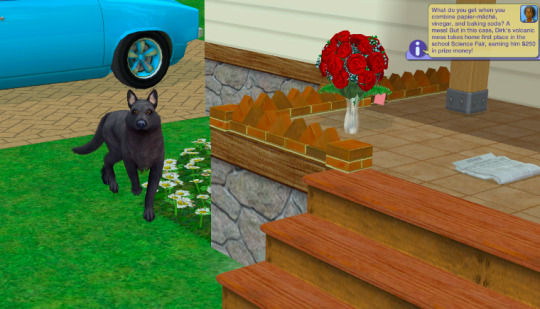
Hardimos: There’s gonna be like five small kids here in a matter of days, combine that with the good foliage here and you got yourself a werewolf pardy.
Urgh – aside from the fact that this werewolf is genuinely following the Brokes around Pleasantview all the way to the Dreamers’ residence (really not that far), Dirk is doing well in Science, and somebody may have left Darren a dream date bouquet.
Welcome to a series I like to call ‘Darren Standing Stiffly At Things’. Exhibition coming soon at the Broke Dreamers Art Gallery... whenever they can afford to buy an art gallery.
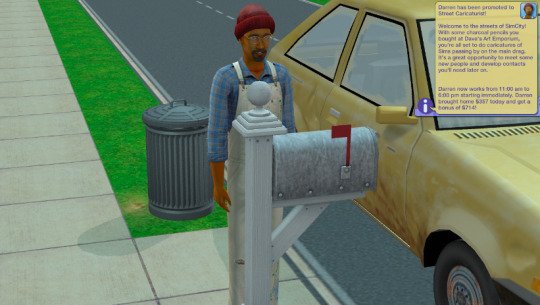

Motionless when it’s great news, or...

... terrible news. Wow, so that scuppers the idea of a nice wedding at a community lot then huh. I guess we could take this ragtag group of the few people who ‘like him enough’ on... some kind of outing?
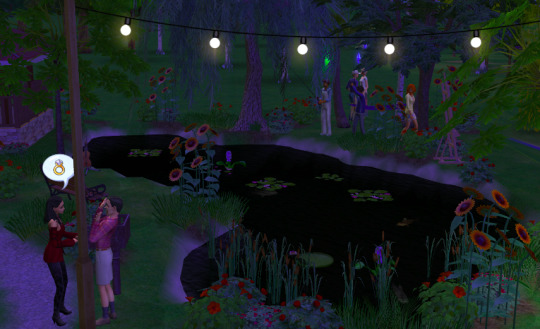
To the Pleasantview Fishing Pond!
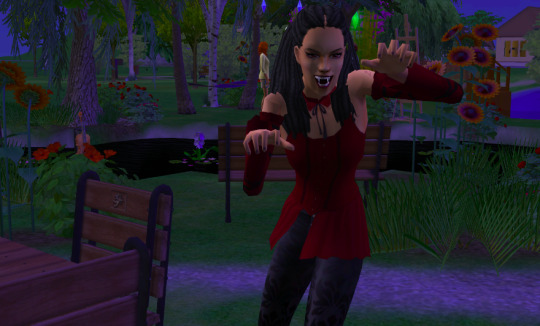
Even vampires like Jennail Tricou like to get in some late-night fishing.
Jennail: I do a bleh and scare all the fish out of the pond.
You do indeed, Jen!
Jennail: It’s not like I even need to eat them, it’s just the satis –
Hold it. This isn’t about you Tricou, you’ll get your turn. Onto Daz’s Dream Outing:

Oh John Burb. In earning that silver gardening badge with all your Nature simming you totally neglected fishing, and are legitimately terrible at it.
John: This’ll never do when I’m trying to impress my wife, dog, cat and three kids on our camping trip to Three Lakes.
I never okayed that, John. Taking Jennifer ‘High Heels’ Burb and a feline animal that can’t live without her Anthropologie pillows camping is tantamount to spousal abuse and animal cruelty.
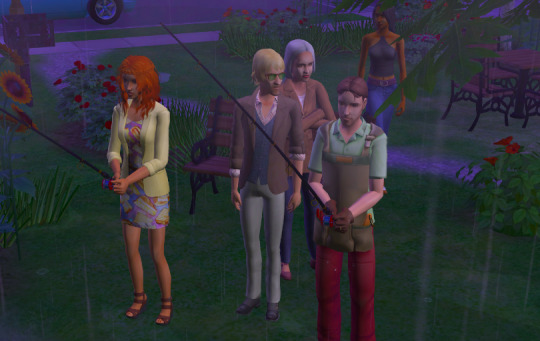
I do love taking sims to community lots just to see who the hell rocks up. As well as Dreamer’s gang of ‘friends’, we ran into none other than my boy Viddy Curious, Everyone’s Favorite Grandma Isabella Monty...
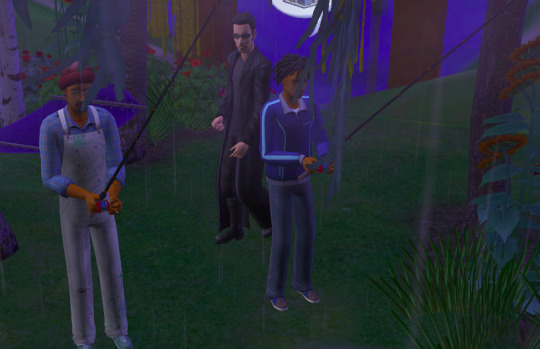
... and motherfreaking John Mole of all people!
John Mole: I’m gathering intel on everybody at this pond.
And doing an excellent job of being inconspicuous you are, John Mole. You just look so very, very normal.
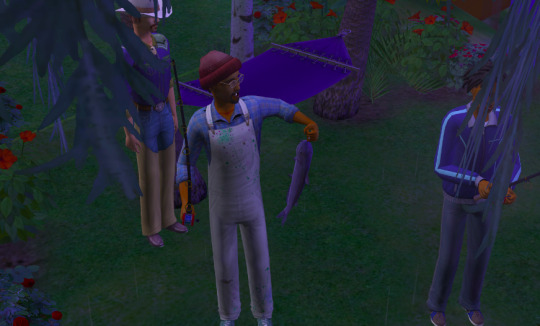
Darren: I’m gonna hang this on my wall and call it art.
Dirk: Could you please make sure you cover it in formaldehyde and vacuum seal it first?
Cowboy Peter Ottomas, you’re everywhere!
Peter: Ah like fishin’! And after witnessing that proposal in TGI Fri – uh in Oresha Family Dining, wanna see how things go with these crazy kids.
Well, for that you’d have to be back at the Dreamer residence where Darren unceremoniously left his fiancée. And on that note...

🎵 Celebrate good times, come on!
Dirk: *retches* Does this nightmare EVER END.
Not when there’s so much dancing to be done! Also, are you retching because of the parental public display of affection? Or is it because Natasha Una has headbutted you in the chest and winded you.
Natasha: IT’S HOW I MAKE FRIENDS.
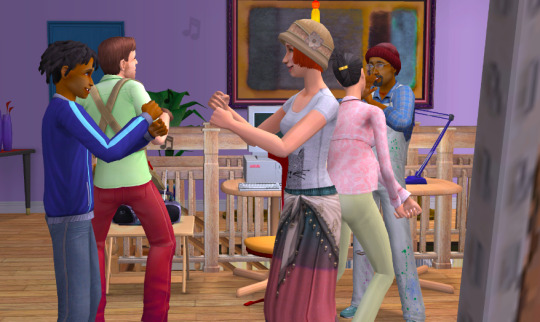
It’s sweet really. Darren’s little group of friends have made quite the little party for him. But when, pray tell, have you ever seen a group of real-life humans randomly dance around a makeshift art studio without the involvement of drugs or alcohol?
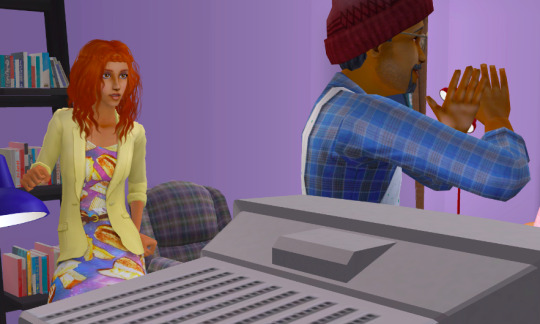
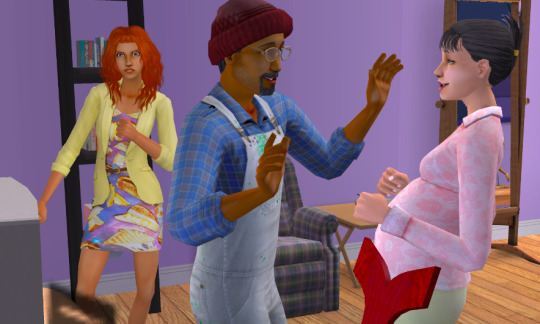
Even Natasha Una is joining the dance-off... awkward as she looks about that.

I knew it! There’s the culprit. Clearly they’ve all been at the Simslice Beer. Enjoy savoring that cold one while you can, Darren, because –

– your new family have arrived, more specifically, The Twins from Hades (dang, now I can’t call Loki and Circe’s kids that).
Skip Jr: The road is a most adrenaline-inducing place to sing myself a nursery rhyme.
Somebody had the patience to teach you the whole thing without punting you over the Pleasantview bridge, SJ? I’m amazed.
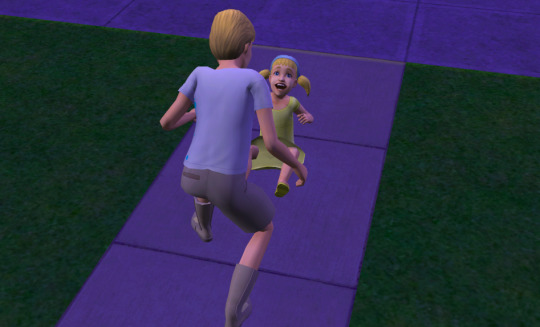
Susie: I’m so excited! And I just can’t hide it! I’m about to lose control –
PLEASE DON’T lose control, with a personality like yours this building will be on fire within seconds.
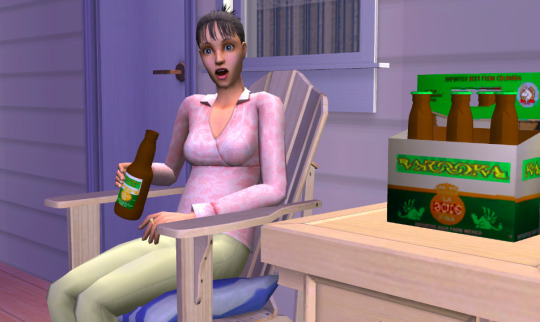
BRANDI!!!
Brandi: What? It’s just one beer, besides, the yeast is good for the babies.
On what planet – hey, if it was Guinness you might have a point when it comes to iron and nutritional value and whatnot but...
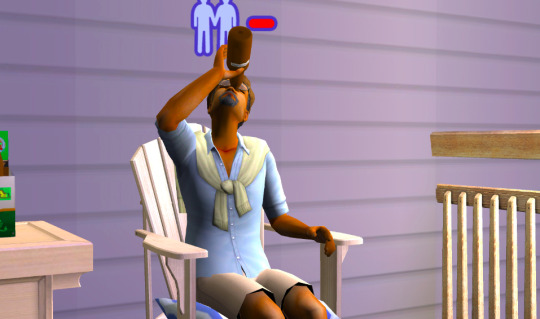
... look what it’s doing to your poor betrothed, he’s drinking it through his fucking eye for pity’s sake.
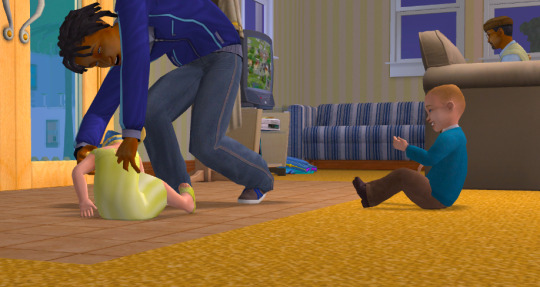
Dirk’s a braver man than most, actively engaging these nightmare children in play with zero prompting. Hey I wonder if somewhere Skip Broke’s ghost is laughing its translucent ass off because his parting gift to the family was a pair of literal demons in embryo form.
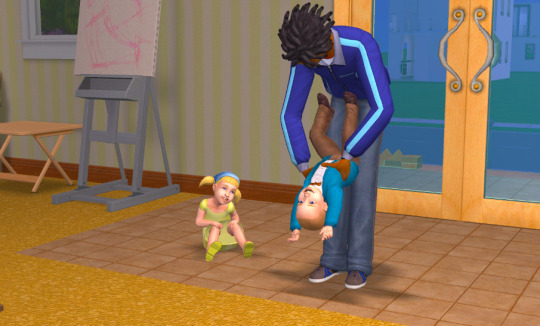
All you Dirk stans out there, I hear your hearts fluttering at this display of adorable. Don’t worry, while I don’t know whether he’ll end up with Lilith or some complete random, he will be blessed with sprogs. We gotta spread those awesome Dreamer genes far and wide.
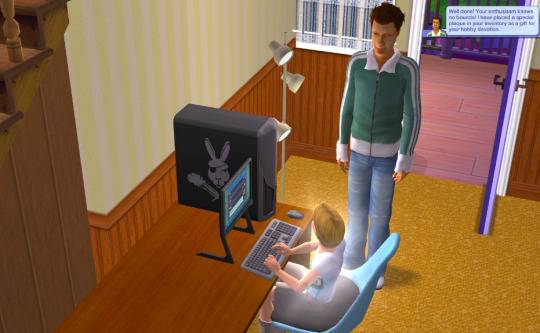
Fair play Beau, you got the glow! Spiky haired music man is impressed! Max enthusiasm as a child, where on earth does he go from here?
Beau: Rockstardom!
Steady on, let’s just see how things go. You’re gonna grow into a Pleasure sim so it’s either the Slacker career for you or... dates. Millions of dates. Ever feel like the Pleasure aspiration got massively sidelined when it came to LTWs? Why not throw the Gamer or Entertainment career in there or something? ‘Hey you can reach the top of this lazy career or, essentially be a watered down Romance sim. THAT’S WHAT YOU GET for wanting to play on the couch and take bubblebaths.’
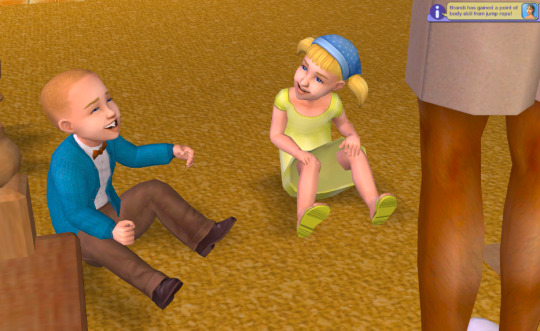
Is Skip Jr. laughing at Daz’s newly hairy legs because I done a overlay? You’ll want your own someday, sunshine. Meanwhile I have a huffing pregnant Brandi jumping rope somewhere in the background because during her last pregnancy she ate when she wasn’t hungry (probably because she was carrying insatiable hellspawn) and her fat token has only just kicked in. I like my sims curvy, but girl rolled the want, gotta give girl what she wants!
(I hope to heavens Marla Biggs, Monica Bratford or Jane Stacks never roll that want. I’ll just ignore them if they do.)

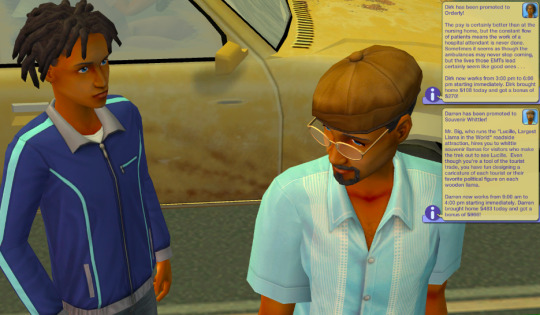
The father and son that carpool together, get promoted together! Dirk’s getting that Medicine career LTW on track nice and early, and Darren’s paintings take too bloody long to paint so he went straight into the Art career. Did I ever tell you he rolled a want to ‘Quit Job’ before his first day?! I nearly falcon punched the computer screen.

And the next day, we get Dirkles promoted again because teenage careers are easy as crap to reach the top of. There ya go Dirk, at least now you get another scholarship, moneylover!
Dirk: I’m just happy to be helping people.
Stop being so perfect.

It’s another Veronaville drive-by! Living for Beau’s casual glance while taking out the trash like a boss.
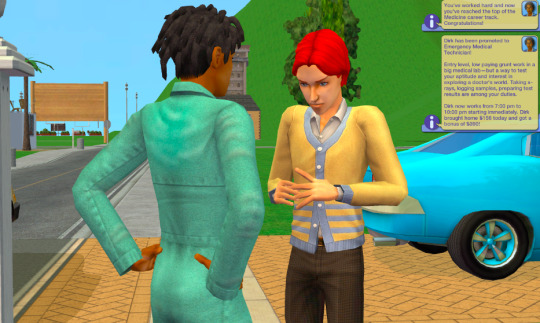
Here you get a little peep at what I’ve done with my Puck. The version I’m opting for is a whiny ‘I JUST WANT TO BE NORMAL’ fairy teen who covers up all traces of his supernatural loveliness, much to his parents’ chagrin. I picture his little sis as the total opposite, rocking up to school with her wings and ears all out giving no shits whatsoever.

What the deuce?! Beau, do you have some kind of sonar for Veronaville residents? It’s like Lucy being Pied Piper to Viper Canyon boys all over again.

Rain concerns Hal. Heck, life concerns Hal. And it’d concern you if you had to live under the same roof as Albany Capp.
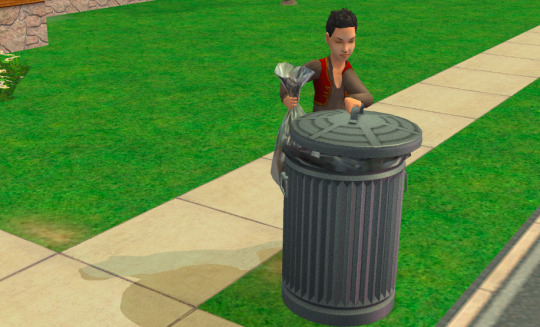
What in the world – Hal THIS ISN’T YOUR HOUSE, have some dignity!
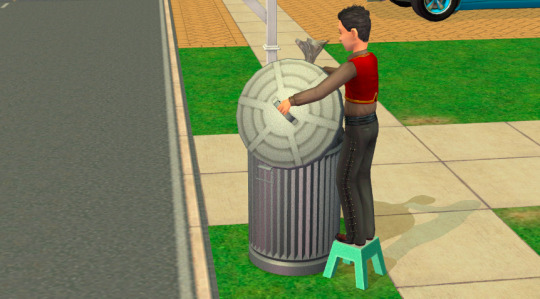
Hal: 🎵Clean up clean up
Everybody everywhere
Clean up clean up
Everybody do your share
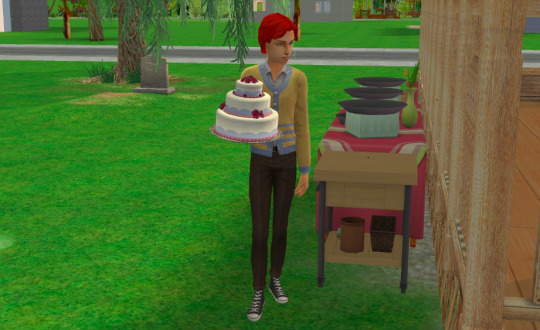
Whawhawha – wait – DON’T LISTEN TO HIM! I had that all set up for the long-awaited backyard wedding, Puck what are you doing!?
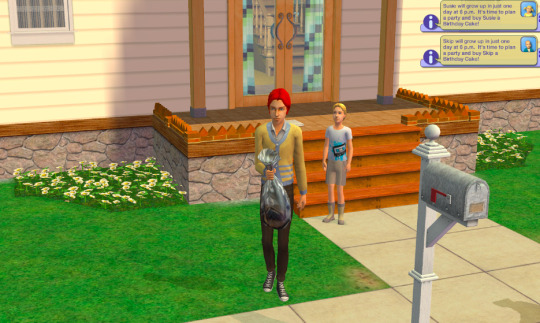
Puck: Takin’ out the trash, V-Ville style!
THE CAKE HADN’T EVEN GONE BAD PUCK, GTF home.
Puck: I don’t want to go home, Hermia and Mercutio will make me lie between them while they do weird stuff to each other again.
I care not. It’s good character-building for the future story I have in mind for you.
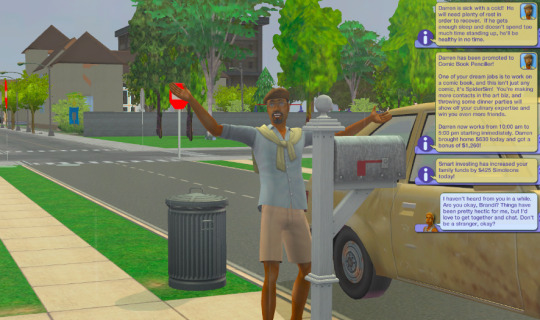
Darren looks so stoked about being sick with the flu. Oh no wait! He got promoted again in one of the easiest careers in christendom. Hahaha, oh Ophelia. ‘Things have been pretty hectic for me’ – like two babies, a wedding and another two babies in a matter of days hectic? Or Johnny bringing you the soda with the caffeine instead of the decaf like you asked hectic. I love your old soul lady, but also, go hang with your age appropriate pals.
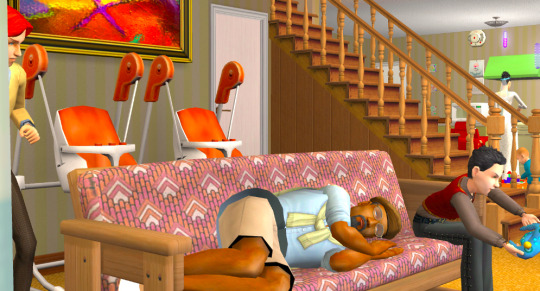
Darren taking the not-standing-up advice pretty literally there while surrounded by gaming Veronavillians. Well, at least they’re doing something relatively normal right now.
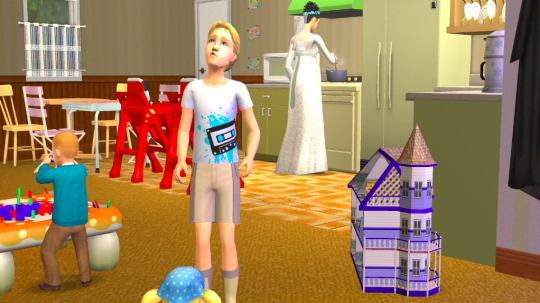
You see what stupidity Darren’s sickness has brought? Brandi’s now having to make Grandma’s comfort soup in her wedding finery, with Beau providing the soundtrack.

‘Well at least you didn’t rent yours at a store called It’s Not Too Late!’
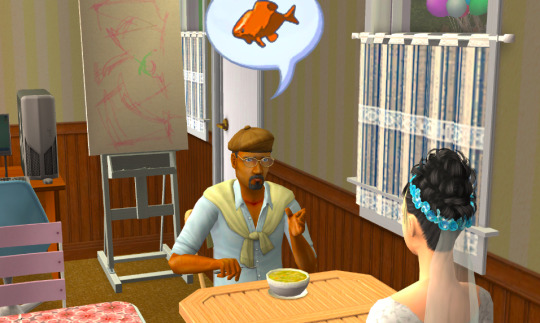
Darren: So in my Nature hobby explorations, I’ve really been getting into fish lately as well as leafs –
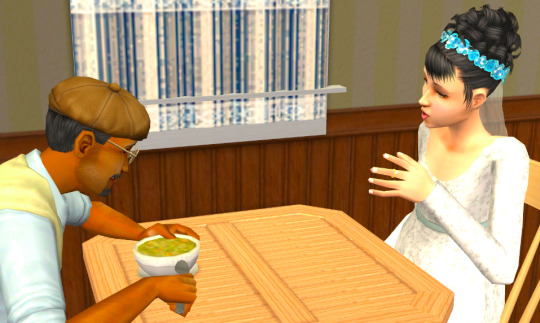
Brandi: Darren, I love you, but if you don’t hurry up and finish that soup so we can get married without you technicolor yawning everywhere and sneezing on the cake I’m gonna go full Hormonal Bridezilla.
Next time, I promise, the knot will be tied, the toddlers will age, and maybe, just maybe, the Broke-Dreamer twins will drop. Ciao for now!
11 notes
·
View notes